The Holocaust
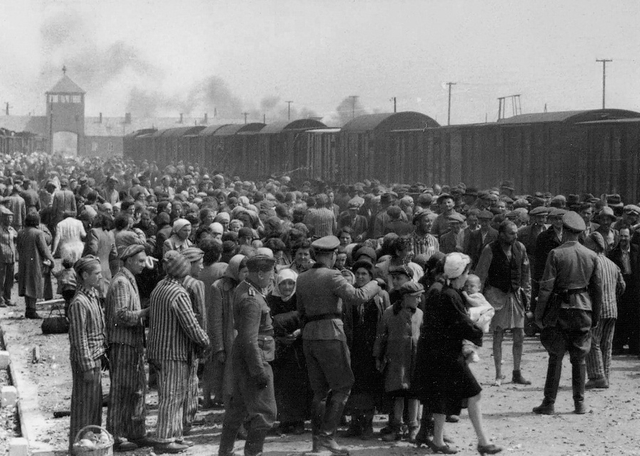
The Holocaust

| The Holocaust | |
|---|---|
| Part of World War II | |
| Description | Genocide of the European Jews |
| Location | Nazi Germany and German-occupied Europe |
| Date | 1941–1945[29] |
Attack type | Genocide, ethnic cleansing |
| Deaths | Around 6 million Jews;[1] other victims of Nazi persecution 11 million[30] |
| Perpetrators | Nazi Germany and its collaborators |
| Motive | Antisemitism |
| Trials | Nuremberg trials, Subsequent Nuremberg trials, Trial of Adolf Eichmann, and others |
The Holocaust, also known as the Shoah,[2] was the World War II genocide of the European Jews. Between 1941 and 1945, across German-occupied Europe, Nazi Germany and its collaborators systematically murdered some six million Jews, around two-thirds of Europe's Jewish population.[1][3] The murders were carried out in pogroms and mass shootings; by a policy of extermination through labour in concentration camps; and in gas chambers and gas vans in German extermination camps, chiefly Auschwitz, Bełżec, Chełmno, Majdanek, Sobibór, and Treblinka in occupied Poland.[32]
Germany implemented the persecution in stages. Following Adolf Hitler's appointment as Chancellor on 30 January 1933, the regime built a network of concentration camps in Germany for political opponents and those deemed "undesirable", starting with Dachau on 22 March 1933.[33] After the passing of the Enabling Act on 24 March,[34] which gave Hitler plenary powers, the government began isolating Jews from civil society, which included a boycott of Jewish businesses in April 1933, and enacting the Nuremberg Laws in September 1935. On 9–10 November 1938, eight months after Germany annexed Austria, Jewish businesses and other buildings were ransacked, smashed or set on fire throughout Germany and Austria during what became known as Kristallnacht (the "Night of Broken Glass"). After Germany invaded Poland in September 1939, triggering World War II, the regime set up ghettos to segregate Jews from the rest of the population. Eventually thousands of camps and other detention sites were established across German-occupied Europe.
The segregation of Jews in ghettos culminated in the policy of extermination the Nazis called the "Final Solution to the Jewish Question", discussed by senior Nazi officials at the Wannsee Conference in Berlin in January 1942. As German forces captured territories in the East, all anti-Jewish measures were radicalized. Under the coordination of the SS, with directions from the highest leadership of the Nazi Party, killings were committed within Germany itself, throughout occupied Europe, and within territories controlled by Germany's allies. Paramilitary death squads called Einsatzgruppen, in cooperation with the German Army and local collaborators, murdered around 1.3 million Jews in mass shootings and pogroms between 1941 and 1945. By mid-1942, victims were being deported from ghettos across Europe in sealed freight trains to extermination camps where, if they survived the journey, they were worked to death or gassed. The killing continued until the end of World War II in Europe in May 1945.
The European Jews were targeted for extermination as part of a larger event during the Holocaust era, usually defined as beginning in January 1933,[35] in which Germany and its collaborators persecuted and murdered other groups, including Slavs (chiefly ethnic Poles, Soviet citizens, and Soviet prisoners of war), the Roma, the "incurably sick", political and religious dissenters, and gay men.[4] The death toll of these groups is thought to rise to 11 million.[30]
| The Holocaust | |
|---|---|
| Part of World War II | |
| Description | Genocide of the European Jews |
| Location | Nazi Germany and German-occupied Europe |
| Date | 1941–1945[29] |
Attack type | Genocide, ethnic cleansing |
| Deaths | Around 6 million Jews;[1] other victims of Nazi persecution 11 million[30] |
| Perpetrators | Nazi Germany and its collaborators |
| Motive | Antisemitism |
| Trials | Nuremberg trials, Subsequent Nuremberg trials, Trial of Adolf Eichmann, and others |
Terminology and scope
Terminology
The term holocaust, first used in 1895 to describe the massacre of Armenians,[36] comes from the Greek: ὁλόκαυστος, romanized: holókaustos; ὅλος hólos, "whole" + καυστός kaustós, "burnt offering".[37][5] The Century Dictionary defined it in 1904 as "a sacrifice or offering entirely consumed by fire, in use among the Jews and some pagan nations".[6]
The biblical term shoah (Hebrew: שׁוֹאָה), meaning "destruction", became the standard Hebrew term for the murder of the European Jews, first used in a pamphlet in 1940, Sho'at Yehudei Polin ("Sho'ah of Polish Jews"), published by the United Aid Committee for the Jews in Poland.[40] On 3 October 1941 the American Hebrew used the phrase "before the Holocaust", apparently to refer to the situation in France,[41] and in May 1943 the New York Times, discussing the Bermuda Conference, referred to the "hundreds of thousands of European Jews still surviving the Nazi Holocaust".[42] In 1968 the Library of Congress created a new category, "Holocaust, Jewish (1939–1945)".[43] The term was popularized in the United States by the NBC mini-series Holocaust (1978), about a fictional family of German Jews,[44] and in November 1978 the President's Commission on the Holocaust was established.[45] As non-Jewish groups began to include themselves as Holocaust victims too, many Jews chose to use the terms Shoah or Churban instead.[41][7] The Nazis used the phrase "Final Solution to the Jewish Question" (German: die Endlösung der Judenfrage).[47]
Definition
Most Holocaust historians define the Holocaust as the enactment, between 1941 and 1945, of the German state policy to exterminate the European Jews.[1] In Teaching the Holocaust (2015), Michael Gray, a specialist in Holocaust education,[56] offers three definitions: (a) "the persecution and murder of Jews by the Nazis and their collaborators between 1933 and 1945", which views the events of Kristallnacht in Germany in 1938 as an early phase of the Holocaust; (b) "the systematic mass murder of the Jews by the Nazi regime and its collaborators between 1941 and 1945", which acknowledges the shift in German policy in 1941 toward the extermination of the Jewish people in Europe; and (c) "the persecution and murder of various groups by the Nazi regime and its collaborators between 1933 and 1945", which includes all the Nazis' victims. The third definition fails, Gray writes, to acknowledge that only the Jewish people were singled out for annihilation.[57]
The United States Holocaust Memorial Museum defines the Holocaust as the "systematic, bureaucratic, state-sponsored persecution and murder of six million Jews by the Nazi regime and its collaborators",[58] distinguishing between the Holocaust and the targeting of other groups during "the era of the Holocaust".[59] According to Yad Vashem, Israel's Holocaust memorial, most historians regard the start of the "Holocaust era" as January 1933, when Hitler was named Chancellor of Germany.[35] Other victims of the Holocaust era include those viewed as inferior (such as the Roma, ethnic Poles, Russians, and the disabled); and those targeted because of their beliefs or behavior (such as Jehovah's Witnesses, communists, and homosexuals).[59] Hitler came to see the Jews as "uniquely dangerous to Germany", according to Peter Hayes, "and therefore uniquely destined to disappear completely from the Reich and all territories subordinate to it". The persecution and murder of other groups was much less consistent. For example, he writes, the Nazis regarded the Slavs as "sub-human", but their treatment consisted of "enslavement and gradual attrition", while "some Slavs—Slovaks, Croats, Bulgarians, some Ukrainians—[were] allotted a favored place in Hitler's New Order".[49]
Dan Stone, a specialist in Holocaust historiography, defines the Holocaust as the genocide of the Jews, whom the Nazis regarded not as racially inferior, deviant, or enemy nationals, as they did other groups, but as a "Gegenrasse: a 'counter-race', that is to say, not really human at all". But he writes that the Holocaust can only be understood as part of the "'Nazi empire' with its grandiose demographic plans".[4] Donald Niewyk and Francis Nicosia, in The Columbia Guide to the Holocaust (2000), favor a definition that focuses on the Jews, Roma, and Aktion T4 victims: "The Holocaust—that is, Nazi genocide—was the systematic, state-sponsored murder of entire groups determined by heredity. This applied to Jews, Gypsies, and the handicapped."[61]
Distinctive features
Genocidal state
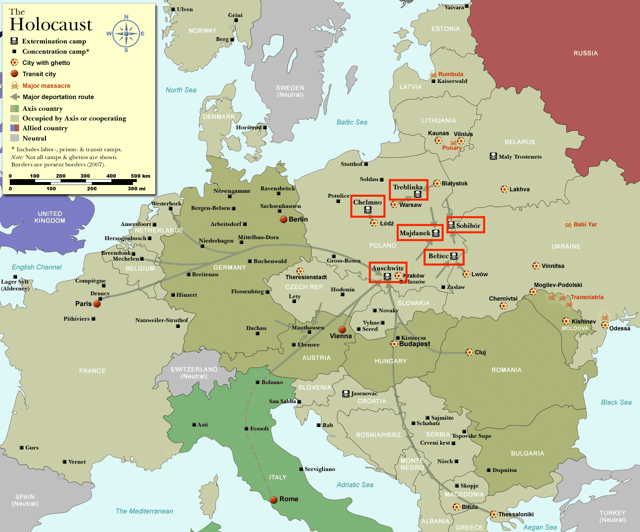
Concentration camps, extermination camps, and ghettos (2007 borders; extermination camps highlighted)

German-occupied Europe, 1942
The logistics of the mass murder turned Germany into what Michael Berenbaum called a "genocidal state".[62] Eberhard Jäckel wrote in 1986 that it was the first time a state had thrown its power behind the idea that an entire people should be wiped out.[8] Anyone with three or four Jewish grandparents was to be exterminated,[64] and complex rules were devised to deal with Mischlinge ("mixed breeds": half and quarter Jews).[65] Bureaucrats identified who was a Jew, confiscated property, and scheduled trains to deport them. Companies fired Jews and later used them as slave labor. Universities dismissed Jewish faculty and students. German pharmaceutical companies tested drugs on camp prisoners; other companies built the crematoria.[62] As prisoners entered the death camps, they were ordered to surrender all personal property, which was catalogued and tagged before being sent to Germany for reuse or recycling.[66] Through a concealed account, the German National Bank helped launder valuables stolen from the victims.[67]
Extermination camps and gas chambers
Victims were transported in sealed freight trains from all over Europe to extermination camps equipped with gas chambers.[68] The stationary facilities grew out of Nazi experiments with poison gas during the Aktion T4 mass murder ("euthanasia") programme against the disabled and mentally ill, which began in 1939.[69] The Germans set up six extermination camps in Poland in 1941–1942: Auschwitz II-Birkenau, Majdanek, Chełmno, and the three Operation Reinhard camps: Bełżec, Sobibór, and Treblinka.[32] Discussions at the Wannsee Conference in January 1942 made it clear that the German "final solution of the Jewish question" was intended eventually to include Britain and all the neutral states in Europe, including Ireland, Switzerland, Turkey, Sweden, Portugal, and Spain.[70]
Collaboration
Historians increasingly view the Holocaust as a pan-European phenomenon, or a series of holocausts impossible to conduct without the help of local collaborators. Without collaborators, the Germans would not have been able to extend the Holocaust across most of the continent.[71][72][73][9] The industrialization and scale of the murder was unprecedented. Killings were systematically conducted in virtually all areas of occupied Europe—more than 20 occupied countries.[75] Nearly three million Jews in occupied Poland and between 700,000 and 2.5 million Jews in the Soviet Union were killed. Hundreds of thousands more died in the rest of Europe.[76] The mass shootings in the occupied Soviet Union, writes Timothy Snyder, "required tens of thousands of participants and was witnessed by hundreds of thousands of people".[77] According to Donald Bloxham, in many parts of Europe "extreme collective violence was becoming an accepted measure of resolving identity crises. ... The Third Reich was a product of the continent as well as the most destructive shaper of it."[78] Some Christian churches defended converted Jews, but otherwise, Saul Friedländer wrote in 2007: "Not one social group, not one religious community, not one scholarly institution or professional association in Germany and throughout Europe declared its solidarity with the Jews ...".[79]
Medical experiments
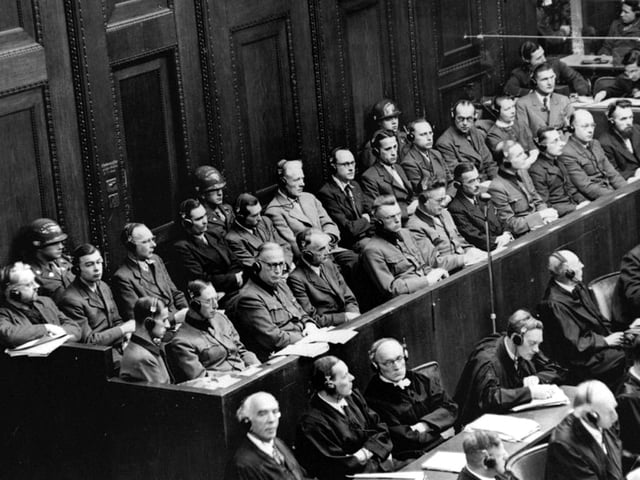
The 23 defendants during the Doctors' trial, Nuremberg, 9 December 1946 – 20 August 1947
Medical experiments conducted on camp inmates by the SS were another distinctive feature.[80] At least 7,000 prisoners were subjected to experiments; most died as a result, during the experiments or later.[81] Twenty-three senior physicians and other medical personnel were charged at Nuremberg, after the war, with crimes against humanity. They included the head of the German Red Cross, tenured professors, clinic directors, and biomedical researchers.[82] Experiments took place at Auschwitz, Buchenwald, Dachau, Natzweiler-Struthof, Neuengamme, Ravensbrück, Sachsenhausen, and elsewhere. Some dealt with sterilization of men and women, the treatment of war wounds, ways to counteract chemical weapons, research into new vaccines and drugs, and the survival of harsh conditions.[81]
The most notorious physician was Josef Mengele, an SS officer who became the Auschwitz camp doctor on 30 May 1943.[83] Interested in genetics[83] and keen to experiment on twins, he would pick out subjects from the new arrivals during "selection" on the ramp, shouting "Zwillinge heraus!" (twins step forward!).[84] They would be measured, killed, and dissected. One of Mengele's assistants said in 1946 that he was told to send organs of interest to the directors of the "Anthropological Institute in Berlin-Dahlem". This is thought to refer to Mengele's academic supervisor, Otmar Freiherr von Verschuer, director from October 1942 of the Kaiser Wilhelm Institute of Anthropology, Human Heredity, and Eugenics in Berlin-Dahlem.[85][84][10] Mengele's experiments included placing subjects in pressure chambers, testing drugs on them, freezing them, attempting to change their eye color by injecting chemicals into children's eyes, and amputations and other surgeries.[88]
Origins
Antisemitism and the völkisch movement
Throughout the Middle Ages in Europe, Jews were subjected to antisemitism based on Christian theology, which blamed them for killing Jesus. Even after the Reformation, Catholicism and Lutheranism continued to persecute Jews, accusing them of blood libels and subjecting them to pogroms and expulsions.[89][90] The second half of the 19th century saw the emergence in the German empire and Austria-Hungary of the völkisch movement, which was developed by such thinkers as Houston Stewart Chamberlain and Paul de Lagarde. The movement embraced a pseudo-scientific racism that viewed Jews as a race whose members were locked in mortal combat with the Aryan race for world domination.[91] These ideas became commonplace throughout Germany,[92] with the professional classes adopting an ideology that did not see humans as racial equals with equal hereditary value.[93] Although the völkisch parties had support in elections at first, by 1914 they were no longer influential. This did not mean that antisemitism had disappeared; instead it was incorporated into the platforms of several mainstream political parties.[92]
Germany after World War I, Hitler's world view
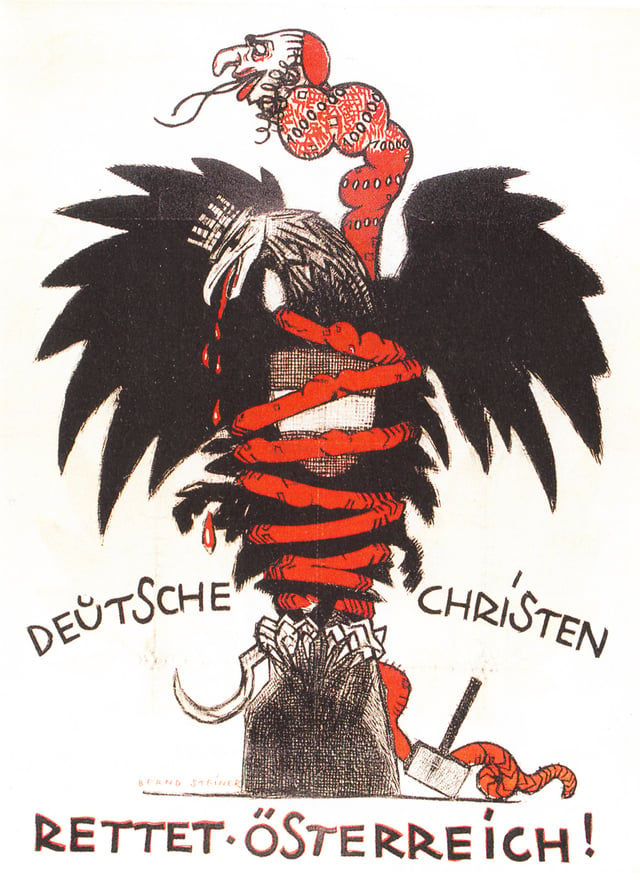
Antisemitic Christian Social Party placard from the 1920 Austrian legislative election: "Vote Christian Socialist. German Christians Save Austria!"[94]
The political situation in Germany and elsewhere in Europe after World War I (1914–1918) contributed to the rise of virulent antisemitism. Many Germans did not accept that their country had been defeated, which gave birth to the stab-in-the-back myth. This insinuated that it was disloyal politicians, chiefly Jews and communists, who had orchestrated Germany's surrender. Inflaming the anti-Jewish sentiment was the apparent over-representation of Jews in the leadership of communist revolutionary governments in Europe, such as Ernst Toller, head of a short-lived revolutionary government in Bavaria. This perception contributed to the canard of Jewish Bolshevism.[95]
The economic strains of the Great Depression led some in the German medical establishment to advocate murder (euphemistically called "euthanasia") of the "incurable" mentally and physically disabled as a cost-saving measure to free up funds for the curable.[96] By the time the National Socialist German Workers' Party, or Nazi Party,[11] came to power in 1933, there was already a tendency to seek to save the racially "valuable", while ridding society of the racially "undesirable".[98] The party had originated in 1920[97] as an offshoot of the völkisch movement, and it adopted that movement's antisemitism.[99] Early antisemites in the party included Dietrich Eckart, publisher of the Völkischer Beobachter, the party's newspaper, and Alfred Rosenberg, who wrote antisemitic articles for it in the 1920s. Rosenberg's vision of a secretive Jewish conspiracy ruling the world would influence Hitler's views of Jews by making them the driving force behind communism.[100] The origin and first expression of Hitler's antisemitism remain a matter of debate.[101] Central to his world view was the idea of expansion and lebensraum (living space) for Germany,[102] in regions of the former Pale of Settlement where most European Jews were living.[103] Open about his hatred of Jews, he subscribed to the common antisemitic stereotypes.[102] From the early 1920s onwards, he compared the Jews to germs and said they should be dealt with in the same way. He viewed Marxism as a Jewish doctrine, said he was fighting against "Jewish Marxism", and believed that Jews had created communism as part of a conspiracy to destroy Germany.[104]
Rise of Nazi Germany
Dictatorship and repression (1933–1939)
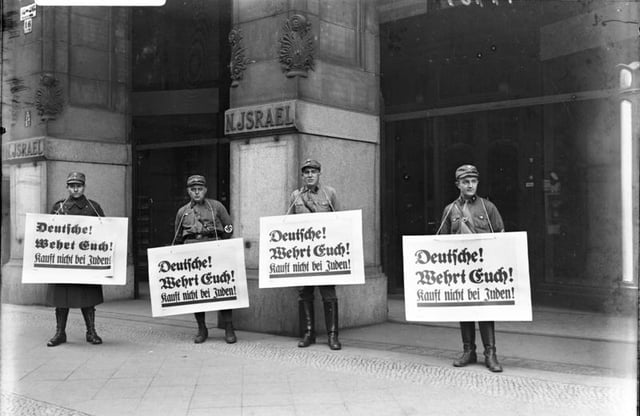
Nazi boycott of Jewish businesses: SA troopers urge a boycott outside Israel's Department Store, Berlin, 1 April 1933. All signs read: "Germans! Defend yourselves! Don't buy from Jews."[105]
With the appointment in January 1933 of Adolf Hitler as Chancellor of Germany, and the Nazi's completed seizure of power, German leaders proclaimed the rebirth of the Volksgemeinschaft ("people's community").[106] Nazi policies divided the population into two groups: the Volksgenossen ("national comrades") who belonged to the Volksgemeinschaft, and the Gemeinschaftsfremde ("community aliens") who did not. Enemies were divided into three groups: the "racial" or "blood" enemies, such as the Jews and Roma; political opponents of Nazism, such as Marxists, liberals, Christians, and the "reactionaries" viewed as wayward "national comrades"; and moral opponents, such as gay men, the work-shy, and habitual criminals. The latter two groups were to be sent to concentration camps for "re-education", with the aim of eventual absorption into the Volksgemeinschaft. "Racial" enemies could never belong to the Volksgemeinschaft; they were to be removed from society.[107]
Before and after the March 1933 Reichstag elections, the Nazis intensified their campaign of violence against opponents,[108] setting up concentration camps for extrajudicial imprisonment.[109] One of the first, at Dachau, opened on 9 March 1933.[110] Initially the camp contained mostly Communists and Social Democrats.[111] Other early prisons were consolidated by mid-1934 into purpose-built camps outside the cities, run exclusively by the SS.[112] The initial purpose of the camps was to serve as a deterrent by terrorizing Germans who did not conform.[113]
Throughout the 1930s, the legal, economic, and social rights of Jews were steadily restricted.[114] On 1 April 1933, there was a boycott of Jewish businesses.[115] On 7 April 1933, the Law for the Restoration of the Professional Civil Service was passed, which excluded Jews and other "non-Aryans" from the civil service.[116] Jews were disbarred from practising law, being editors or proprietors of newspapers, joining the Journalists' Association, or owning farms.[117] In Silesia, in March 1933, a group of men entered the courthouse and beat up Jewish lawyers; Friedländer writes that, in Dresden, Jewish lawyers and judges were dragged out of courtrooms during trials.[118] Jewish students were restricted by quotas from attending schools and universities.[116] Jewish businesses were targeted for closure or "Aryanization", the forcible sale to Germans; of the approximately 50,000 Jewish-owned businesses in Germany in 1933, about 7,000 were still Jewish-owned in April 1939. Works by Jewish composers,[119] authors, and artists were excluded from publications, performances, and exhibitions.[120] Jewish doctors were dismissed or urged to resign. The Deutsches Ärzteblatt (a medical journal) reported on 6 April 1933: "Germans are to be treated by Germans only."[121]
Sterilization Law, Aktion T4
The Nazis used the phrase Lebensunwertes Leben (life unworthy of life) in reference to the disabled and mentally ill.[123] On 14 July 1933, the Law for the Prevention of Hereditarily Diseased Offspring (Gesetz zur Verhütung erbkranken Nachwuchses), the Sterilization Law, was passed, allowing for compulsory sterilization.[124][125] The New York Times reported on 21 December that year: "400,000 Germans to be sterilized".[126] There were 84,525 applications from doctors in the first year. The courts reached a decision in 64,499 of those cases; 56,244 were in favor of sterilization.[127] Estimates for the number of involuntary sterilizations during the whole of the Third Reich range from 300,000 to 400,000.[128]
In October 1939 Hitler signed a "euthanasia decree" backdated to 1 September 1939 that authorized Reichsleiter Philipp Bouhler, the chief of Hitler's Chancellery, and Karl Brandt, Hitler's personal physician, to carry out a program of involuntary "euthanasia"; after the war this program was named Aktion T4.[129] It was named after Tiergartenstraße 4, the address of a villa in the Berlin borough of Tiergarten, where the various organizations involved were headquartered.[130] T4 was mainly directed at adults, but the "euthanasia" of children was also carried out.[131] Between 1939 and 1941, 80,000 to 100,000 mentally ill adults in institutions were killed, as were 5,000 children and 1,000 Jews, also in institutions. In addition there were specialized killing centres, where the deaths were estimated at 20,000, according to Georg Renno, the deputy director of Schloss Hartheim, one of the "euthanasia" centers, or 400,000, according to Frank Zeireis, the commandant of the Mauthausen concentration camp.[132] Overall, the number of mentally and physically handicapped murdered was about 150,000.[133]
Although not ordered to take part, psychiatrists and many psychiatric institutions were involved in the planning and carrying out of Aktion T4 at every stage.[134] After protests from the German Catholic and Protestant churches, Hitler ordered the cancellation of the T4 program in August 1941,[135] although the disabled and mentally ill continued to be killed until the end of the war.[133] The medical community regularly received bodies and body parts for research. University of Tübingen received 1,077 bodies from executions between 1933 and 1945. The neuroscientist Julius Hallervorden received 697 brains from one hospital between 1940 and 1944: "I accepted these brains of course. Where they came from and how they came to me was really none of my business."[136]
Nuremberg Laws, Jewish emigration
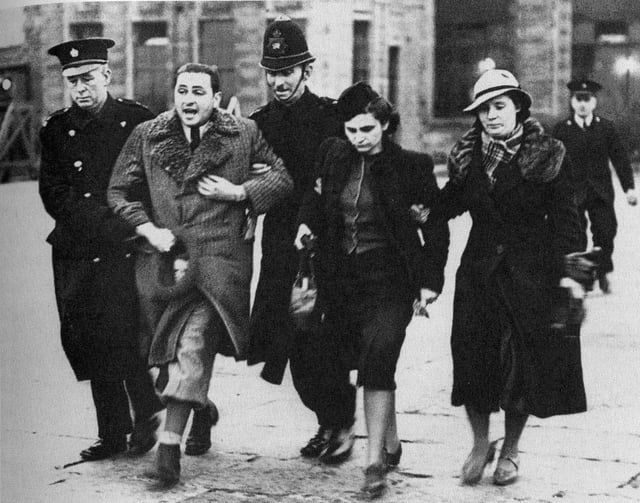
Czechoslovakian Jews at Croydon airport, England, 31 March 1939, before deportation to Poland[137]
On 15 September 1935, the Reichstag passed the Reich Citizenship Law and the Law for the Protection of German Blood and German Honor, known as the Nuremberg Laws. The former said that only those of "German or kindred blood" could be citizens. Anyone with three or more Jewish grandparents was classified as a Jew.[138] The second law said: "Marriages between Jews and subjects of the state of German or related blood are forbidden." Sexual relationships between them were also criminalized; Jews were not allowed to employ German women under the age of 45 in their homes.[139][138] The laws referred to Jews but applied equally to the Roma and black Germans. Other European countries—Bulgaria, Croatia, Hungary, Italy, Romania, Slovakia, and Vichy France—passed similar legisation.[138]
50,000 German Jews had left Germany by the end of 1934,[140] and by the end of 1938, approximately half the German Jewish population had left the country.[141] Among the prominent Jews who left was the conductor Bruno Walter, who fled after being told that the hall of the Berlin Philharmonic would be burned down if he conducted a concert there.[142] Albert Einstein, who was in the United States when Hitler came to power, never returned to Germany; he was expelled from the Kaiser Wilhelm Society and the Prussian Academy of Sciences and his citizenship was revoked.[143] Other Jewish scientists, including Gustav Hertz, lost their teaching positions and left the country.[144]
Anschluss

March or April 1938: Jews are forced to scrub the pavement in Vienna.
On 12 March 1938, Germany annexed Austria. Austrian Nazis broke into Jewish shops, stole from Jewish homes and businesses, and forced Jews to perform humiliating acts such as scrubbing the streets or cleaning toilets.[145] Jewish businesses were "Aryanized", and all the legal restrictions on Jews in Germany were imposed.[146] In August that year, Adolf Eichmann was put in charge of the Central Agency for Jewish Emigration in Vienna (Zentralstelle für jüdische Auswanderung in Wien). About 100,000 Austrian Jews had left the country by May 1939, including Sigmund Freud and his family, who moved to London.[147] The Évian Conference was held in France in July 1938 by 32 countries, as an attempt to help the increased refugees from Germany, but aside from establishing the largely ineffectual Intergovernmental Committee on Refugees, little was accomplished and most countries participating did not increase the number of refugees they would accept.[148]
Kristallnacht
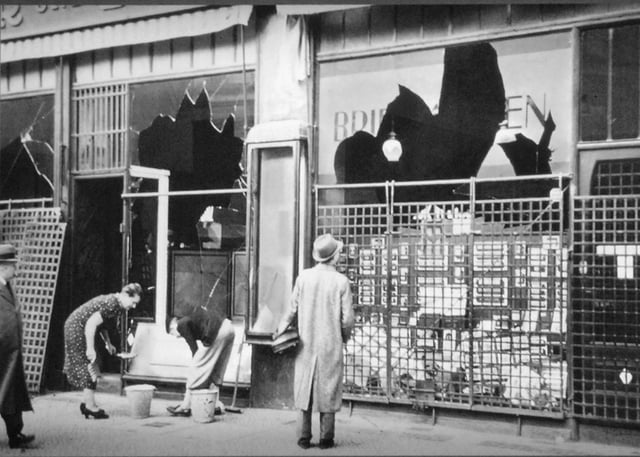
Potsdamer Straße 26, Berlin, the day after Kristallnacht, November 1938
On 7 November 1938, Herschel Grynszpan, a Polish Jew, shot the German diplomat Ernst vom Rath in the German Embassy in Paris, in retaliation for the expulsion of his parents and siblings from Germany.[149][12] When vom Rath died on 9 November, the government used his death as a pretext to instigate a pogrom against the Jews. The government claimed it was spontaneous, but in fact it had been ordered and planned by Adolf Hitler and Joseph Goebbels, although with no clear goals, according to David Cesarani. The result, he writes, was "murder, rape, looting, destruction of property, and terror on an unprecedented scale".[151]
Known as Kristallnacht (or "Night of Broken Glass"), the attacks on 9–10 November 1938 were partly carried out by the SS and SA,[152] but ordinary Germans joined in; in some areas, the violence began before the SS or SA arrived.[153] Over 7,500 Jewish shops (out of 9,000) were looted and attacked, and over 1,000 synagogues damaged or destroyed. Groups of Jews were forced by the crowd to watch their synagogues burn; in Bensheim they were made to dance around it, and in Laupheim to kneel before it.[154] At least 90 Jews died. The damage was estimated at 39 million Reichmarks.[155] Cesarani writes that "[t]he extent of the desolation stunned the population and rocked the regime."[156] It also shocked the rest of the world. The Times of London wrote on 11 November 1938: "No foreign propagandist bent upon blackening Germany before the world could outdo the tale of burnings and beatings, of blackguardly assaults upon defenseless and innocent people, which disgraced that country yesterday. Either the German authorities were a party to this outbreak or their powers over public order and a hooligan minority are not what they are proudly claimed to be."[157]
Between 9 and 16 November, 30,000 Jews were sent to the Buchenwald, Dachau, and Sachsenhausen concentration camps.[158] Many were released within weeks; by early 1939, 2,000 remained in the camps.[159] German Jewry was held collectively responsible for restitution of the damage; they also had to pay an "atonement tax" of over a billion Reichmarks. Insurance payments for damage to their property were confiscated by the government. A decree on 12 November 1938 barred Jews from most remaining occupations.[160] Kristallnacht marked the end of any sort of public Jewish activity and culture, and Jews stepped up their efforts to leave the country.[161]
Territorial solution and resettlement
Before World War II, Germany considered mass deportation from Europe of German, and later European, Jewry.[162] Among the areas considered for possible resettlement were British Palestine[163] and French Madagascar.[164] After the war began, German leaders considered deporting Europe's Jews to Siberia.[165][166] Palestine was the only location to which any German relocation plan produced results, via the Haavara Agreement between the Zionist Federation of Germany and the German government.[167] This resulted in the transfer of about 60,000 German Jews and $100 million from Germany to Palestine, but it ended with the outbreak of World War II.[168] In May 1940 Madagascar became the focus of new deportation efforts[164] because it had unfavorable living conditions that would hasten deaths.[169] Several German leaders had discussed the idea in 1938, and Adolf Eichmann's office was ordered to carry out resettlement planning, but no evidence of planning exists until after the fall of France in June 1940.[170] But the inability to defeat Britain prevented the movement of Jews across the seas,[171] and the end of the Madagascar Plan was announced on 10 February 1942.[172]
World War II
Occupied countries
Poland
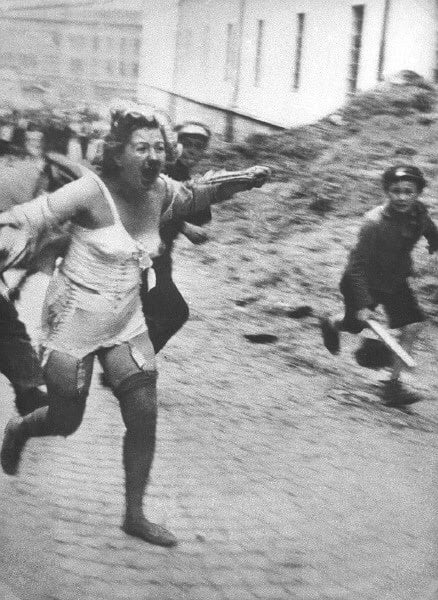
Woman chased by youths armed with clubs during the Lviv pogroms, July 1941, then occupied Poland, now Ukraine
There were anti-Jewish pogroms in around 100 towns in Poland between 1935 and 1937,[173] and again in 1938.[174] When Germany invaded Poland on 1 September 1939, it gained control of about two million Jews in the occupied territory. The rest of the country, with a pre-war population of 3.3–3.5 million Jews, was occupied by the Soviet Union, which invaded Poland from the east on 17 September 1939.[175] German plans for Poland included expelling gentile Poles from large areas, confining Jews, and settling Germans on the emptied lands.[176] The Germans initiated a policy of sending Jews from all territories they had recently annexed (Austria, Czechoslovakia, and western Poland) to the central section of Poland, which they called the Generalgouvernement. There, the Jews were concentrated in ghettos in major cities,[177] chosen for their railway lines to facilitate later deportation.[178] Food supplies were restricted, public hygiene was difficult, and the inhabitants were often subjected to forced labor.[179] In the work camps and ghettos, at least half a million Jews died of starvation, disease, and poor living conditions.[180] Jeremy Black writes that the ghettos were not intended, in 1939, as a step towards the extermination of the Jews. Instead, they were viewed as part of a policy of creating a territorial reservation to contain them.[181][13]
During the Lviv pogroms in Lwów, Poland (now Lviv, Ukraine), around 6,000 Polish Jews were murdered in the streets in June and July 1941 by Ukrainian People's Militia and local people.[191][14] Another 2,500–3,500 Jews died in mass shootings by Einsatzgruppe C.[192] During the Jedwabne pogrom, on 10 July 1941, a group of Poles in Jedwabne killed the town's Jewish community, many of whom were burned alive in a barn. According to Jan T. Gross, close to 1,600 men, women and children died;[193] an archeologist who exhumed some of the bodies in 2001 placed the death toll at 300–400.[194] The attack may have been engineered by the German Security Police.[195] A long debate about the murders was triggered in 2001 by the publication of Gross's book Neighbors: The Destruction of the Jewish Community in Jedwabne, Poland.[196]
Norway and Denmark
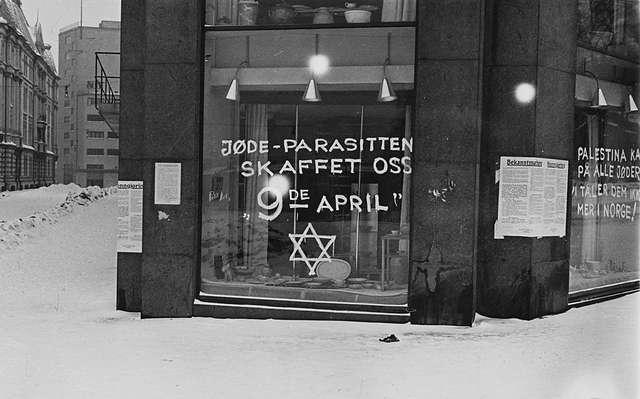
Antisemitic graffiti, Oslo, 1941
Germany invaded Norway and Denmark on 9 April 1940, during Operation Weserübung. Denmark was overrun so quickly that there was no time for an organized resistance to form. Consequently, the Danish government stayed in power and the Germans found it easier to work through it. Because of this, few measures were taken against the Danish Jews before 1942.[197] By June 1940 Norway was completely occupied.[198] In late 1940, the country's 1,800 Jews were banned from certain occupations, and in 1941 all Jews had to register their property with the government.[199] On 26 November 1942, 532 Jews were taken by police officers, at four o'clock in the morning, to Oslo harbour, where they boarded a German ship. From Germany they were sent by freight train to Auschwitz. According to Dan Stone, only nine survived the war.[200]
France and the Low Countries
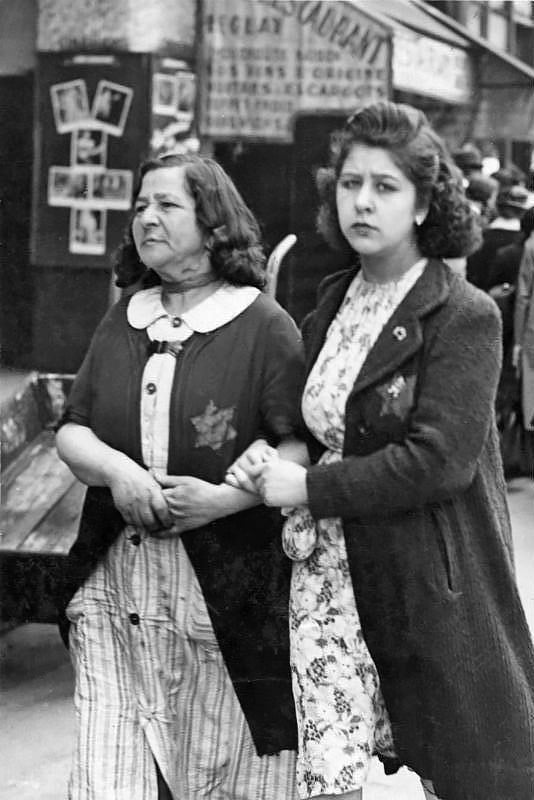
Jewish women wearing yellow badges in occupied Paris, June 1942
In May 1940, Germany invaded the Netherlands, Luxembourg, Belgium, and France. After Belgium's surrender, it was ruled by a German military governor, Alexander von Falkenhausen, who enacted anti-Jewish measures against the country's 90,000 Jews, many of whom were refugees from Germany or Eastern Europe.[201]
In the Netherlands, the Germans installed Arthur Seyss-Inquart as Reichskommissar, who began to persecute the country's 140,000 Jews. Jews were forced out of their jobs and had to register with the government. In February 1941, non-Jewish Dutch citizens staged a strike in protest that was quickly crushed.[202] From July 1942, over 107,000 Dutch Jews were deported; only 5,000 survived the war. Most were sent to the extermination camp at Auschwitz; the first transport of 1,135 Jews left Holland for Auschwitz on 15 July 1942. Between 2 March and 20 July 1943, 34,313 Jews were sent in 19 transports to the Sobibór extermination camp, where all but 18 are thought to have been gassed on arrival.[203]
France had approximately 300,000 Jews, divided between the German-occupied north and the unoccupied collaborationist southern areas in Vichy France (named after the town Vichy). The occupied regions were under the control of a military governor, and there, anti-Jewish measures were not enacted as quickly as they were in the Vichy-controlled areas.[204] In July 1940, the Jews in the parts of Alsace-Lorraine that had been annexed to Germany were expelled into Vichy France.[205] Vichy France's government implemented anti-Jewish measures in French Algeria and the two French Protectorates of Tunisia and Morocco.[206] Tunisia had 85,000 Jews when the Germans and Italians arrived in November 1942; an estimated 5,000 Jews were subjected to forced labor.[207]
Yugoslavia and Greece
Yugoslavia and Greece were invaded in April 1941 and surrendered before the end of the month. Germany and Italy divided Greece into occupation zones but did not eliminate it as a country. Yugoslavia, home to around 80,000 Jews, was dismembered; regions in the north were annexed by Germany and regions along the coast made part of Italy. The rest of the country was divided into the Independent State of Croatia, nominally an ally of Germany, and Serbia, which was governed by a combination of military and police administrators.[208] According to historian Jeremy Black, Serbia was declared free of Jews in August 1942.[209] Croatia's ruling party, the Ustashe, killed the majority of the country's Jews, and killed or expelled from the area local Orthodox Christian Serbs and Muslims.[208] Jews and Serbs alike were "hacked to death and burned in barns", according to Black. One difference between the Germans and Croatians was that the Ustashe allowed its Jewish and Serbian victims to convert to Catholicism so they could escape death.[209]
Soviet Union
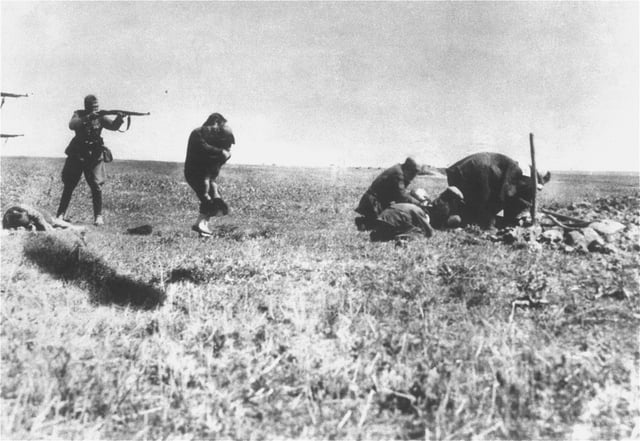
Ivanhorod Einsatzgruppen photograph: Einsatzgruppe shooting a woman and child, near Ivangorod, Ukraine, 1942[210]
Germany invaded the Soviet Union on 22 June 1941, a day Timothy Snyder calls "one of the most significant days in the history of Europe ... the beginning of a calamity that defies description".[211] For Jürgen Matthäus, the invasion was "a watershed in history, a quantum leap toward the Holocaust", an event that turned the "Wehrmacht, SS, German police and civil agencies, allied troops [and] local collaborators" into perpetrators.[212] By the end of 1941, according to Matthäus, 500,000–800,000 Jews (2,700–4,200 a day) had been killed in mass shootings.[213] Between the early fall 1941 and late spring 1942, he writes, 2 million of the 3.5 million Soviet soldiers captured by the Wehrmacht had been executed or had died of neglect and abuse: "By the time of their final withdrawal in 1944, the Germans had destroyed most of the infrastructure of the occupied territory, burned thousands of villages, and depopulated vast areas. Total Soviet losses are difficult to estimate, but a figure of at least twenty million seems likely."[214]
German propaganda portrayed the war against the Soviet Union as both an ideological one between German National Socialism and Jewish Bolshevism, and a racial war between the Germans and the Jewish, Romani and Slavic Untermenschen ("sub-humans").[215] Local populations in some occupied Soviet territories actively participated in the killing of Jews and others, and helped identify and round up Jews.[216] In Lithuania, Latvia, and western Ukraine, locals were deeply involved in the murders. Some Latvian and Lithuanian units also participated in the murder of Jews in Belarus. In the south, Ukrainians killed about 24,000 Jews; some went to Poland to serve as guards in the concentration and extermination camps.[216]
Mass shootings
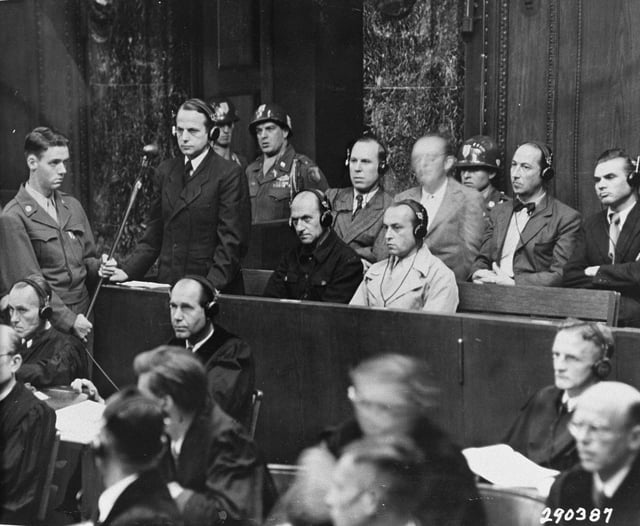
Otto Ohlendorf, commander of Einsatzgruppe D, pleads not guilty during the Einsatzgruppen trial, Nuremberg, 15 September 1947. He was executed in 1951.
The mass killings of Jews in the occupied Soviet territories was assigned to SS formations called Einsatzgruppen ("task forces") under the command of SS-Obergruppenführer Reinhard Heydrich, head of the Reich Security Head Office.[217] These had been used to a limited extent in Poland in 1939 to murder, among others, Jews and the intelligentsia,[218] but they were organized in the Soviet territories on a much larger scale. Their role was to deal with "all anti-German elements in hostile country behind the troops in combat".[219] The Einsatzgruppen commanders were ordinary citizens: the great majority were professionals, and most were intellectuals; Snyder writes that 15 of the 20 Einsatzgruppe and Einsatzcommando leaders had PhDs.[220]
Typically, victims would undress and give up their valuables before lining up beside a ditch to be shot, or they would be forced to climb into the ditch, lie on a lower layer of corpses, and wait to be killed.[221] The latter was known as Sardinenpackung ("packing sardines"), a method reportedly started by SS officer Friedrich Jeckeln.[222] Travelling with nine German Order Police battalions and three units of the Waffen-SS,[223] the Einsatzgruppen and their local collaborators had murdered almost 500,000 people in this fashion by the winter of 1941–1942,[224] and around two million by the end of the war. About 1.3 million were Jews, and up to a quarter of a million were Roma.[225]
In the July 1941 Ponary massacre near Vilnius (then part of Soviet Lithuania), 72,000 Jews and 8,000 non-Jewish Lithuanians and Poles were shot by Einsatgruppe B and Lithuanian collaborators.[226] In the Kamianets-Podilskyi massacre (then within Soviet Ukraine), nearly 24,000 Jews were killed between 27 and 30 August 1941.[214] The largest massacre was at a ravine called Babi Yar outside Kiev (also within Soviet Ukraine), where 33,771 Jews were killed in a single operation on 29–30 September 1941.[227][15] Men from Einsatzgruppe C and the Order Police, assisted by Ukrainian militia, carried out the killings,[229] while the German 6th Army helped round up and transport the victims to be shot.[230] The German armed forces (the Wehrmacht) accepted no responsibility for the Einsatzgruppen. According to Deborah Dwork and Robert Jan van Pelt, they at first lamented the shootings, then became active collaborators,[231] which included taking part in shootings themselves. To justify their troops' involvement, Wehrmacht commanders would describe the victims as "hostages", "bandits" and "partisans".[232]
Germany's allies
Romania
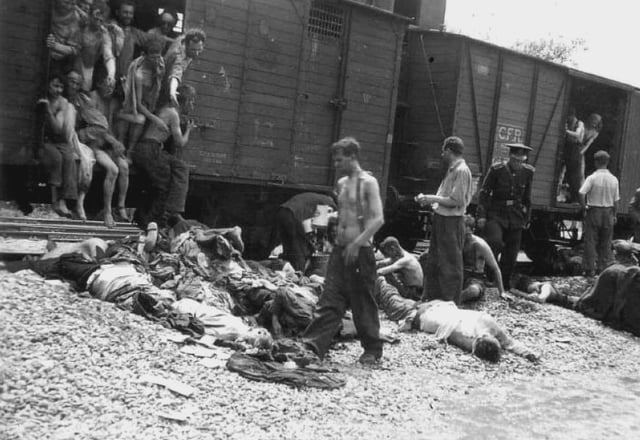
Bodies being pulled out of a train carrying Romanian Jews from the Iași pogrom, July 1941
Dan Stone writes that, although the murder of Jews in Romania took place under the umbrella of the Nazis, it was "essentially an independent undertaking".[233] Romania implemented anti-Jewish measures in May and June 1940 as part of its efforts towards an alliance with Germany. Jews were forced from government service, pogroms were carried out, and by March 1941 all Jews had lost their jobs and had their property confiscated.[234] In June 1941 Romania joined the invasion of the Soviet Union. Thousands of Jews were killed in January and June 1941 in the Bucharest pogrom and Iaşi pogrom.[235] According to a 2004 report by Tuvia Friling and others, up to 14,850 Jews died during the Iaşi pogrom.[236] The Romanian military killed up to 25,000 Jews during the Odessa massacre between 18 October 1941 and March 1942, assisted by gendarmes and the police.[237] Mihai Antonescu, Romania's deputy prime minister, was reported to have said it was "the most favorable moment in our history" to solve the "Jewish problem".[238] In July 1941 he said it was time for "total ethnic purification, for a revision of national life, and for purging our race of all those elements which are foreign to its soul, which have grown like mistletoes and darken our future".[239] Romania set up concentration camps under its control in Transnistria, where 154,000–170,000 Jews were deported from 1941 to 1943.[234]
Bulgaria, Slovakia, Hungary
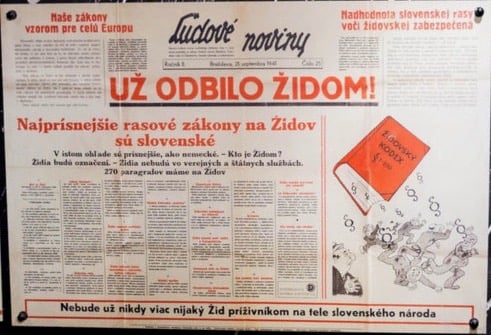
A Slovakian propaganda ministry's publication, Ľudové noviny, 21 September 1941: "Už odbilo Židom! Najprísnejšie rasové zákony na Židov sú slovenské" ("We've dealt with the Jews! The strictest anti-Jewish laws are Slovakian")
Bulgaria introduced anti-Jewish measures in 1940 and 1941, including the requirement to wear a yellow star, the banning of mixed marriages, and the loss of property. It annexed Thrace and Macedonia, and in February 1943 agreed to deport 20,000 Jews to Treblinka; all 11,000 Jews from the annexed territories were sent to their deaths, and plans were made to deport an additional 6,000–8,000 Bulgarian Jews from Sofia to meet the quota.[240] When the plans became public, the Orthodox Church and many Bulgarians protested, and King Boris III canceled the deportation of Jews native to Bulgaria.[241] Instead, they were expelled to the interior pending further decision.[240]
Dan Stone writes that Slovakia, led by Roman Catholic priest Jozef Tiso (president of the Slovak State, 1939–1945), was "one of the most loyal of the collaborationist regimes". It deported 7,500 Jews in 1938 on its own initiative; introduced anti-Jewish measures in 1940; and by the autumn of 1942 had deported around 60,000 Jews to ghettos and concentration camps in Poland. Another 2,396 were deported and 2,257 killed that autumn during an uprising, and 13,500 were deported between October 1944 and March 1945.[242] According to Stone, "the Holocaust in Slovakia was far more than a German project, even if it was carried out in the context of a 'puppet' state."[243]
Although Hungary expelled Jews who were not citizens from its newly annexed lands in 1941, it did not deport most of its Jews[244] until the German invasion of Hungary in March 1944. Between 15 May and 9 July 1944, 440,000 Hungarian Jews were deported to Auschwitz.[245] In late 1944 in Budapest, nearly 80,000 Jews were killed by the Hungarian Arrow Cross battalions.[246]
Other allies
Italy introduced some antisemitic measures, but there was less antisemitism there than in Germany, and Italian-occupied countries were generally safer for Jews than German-occupied territories. In some areas, the Italian authorities even tried to protect Jews, such as in the Croatian areas of the Balkans. But while Italian forces in Russia were not as vicious towards Jews as the Germans, they did not try to stop German atrocities either. There were no deportations of Italian Jews to Germany while Italy remained an ally.[247] Several forced labor camps for Jews were established in Italian-controlled Libya. Almost 2,600 Libyan Jews were sent to camps, where 562 died.[248]
Finland was pressured in 1942 to hand over its 150–200 non-Finnish Jews to Germany. After opposition from the government and public, eight non-Finnish Jews were deported in late 1942; only one survived the war.[249] Japan had little antisemitism in its society and did not persecute Jews in most of the territories it controlled. Jews in Shanghai were confined, but despite German pressure they were not killed.[250]
Gas vans
As the mass shootings continued in Russia, the Germans began to search for more efficient methods of mass murder. Himmler and his subordinates in the field feared that the shootings were causing psychological problems in the SS.[251] In December 1939 and January 1940, experimental gas vans equipped with gas cylinders and a sealed compartment were used to kill the disabled and mentally-ill in occupied Poland.[252] Similar vans, but using the exhaust fumes rather than bottled gas, were introduced to the Chełmno extermination camp in December 1941,[253] and some were used in the occupied Soviet Union, for example in smaller clearing actions in the Minsk ghetto.[254] They also were used in Yugoslavia.[255] Apparently, like the mass shootings, the vans also caused emotional problems for the operators, and the small number of victims the vans could handle made them ineffective.[256]
Ghettos
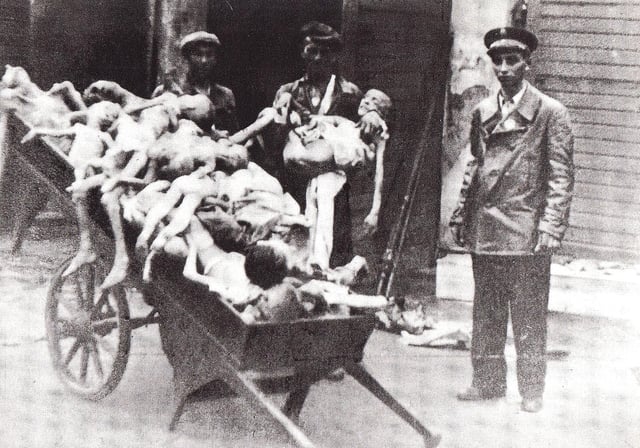
Bodies of children in the Warsaw Ghetto, 1941 or 1942
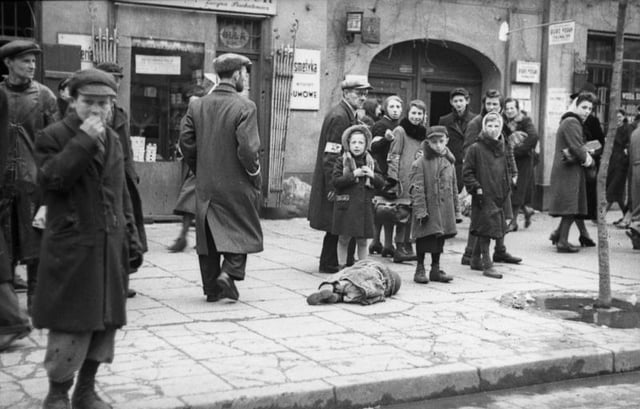
Warsaw Ghetto, May 1941
After invading Poland, the Germans established ghettos in the incorporated territories and General Government to confine Jews.[177] The ghettos were formed and closed off from the outside world at different times and for different reasons.[257][258] For example, the Łódź ghetto was closed in April 1940,[177] to force the Jews inside to give up money and valuables;[259] the Warsaw ghetto was closed for health considerations (for the people outside, not inside, the ghetto),[260] but this did not happen until November 1940;[177] and the Kraków ghetto was not established until March 1941.[261] The Warsaw Ghetto contained 380,000 people[177] and was the largest ghetto in Poland; the Łódź Ghetto was the second largest,[262] holding between 160,000[263] to 223,000.[264] Because of the long drawn-out process of establishing ghettos, it is unlikely that they were originally considered part of a systematic attempt to eliminate Jews completely.[265]
The Germans required each ghetto to be run by a Judenrat, or Jewish council.[266] Councils were responsible for a ghetto's day-to-day operations, including distributing food, water, heat, medical care, and shelter. The Germans also required councils to confiscate property, organize forced labor, and, finally, facilitate deportations to extermination camps.[267] The councils' basic strategy was one of trying to minimize losses, by cooperating with German authorities, bribing officials, and petitioning for better conditions or clemency.[268]
Eventually, the Germans ordered the councils to compile lists of names of deportees to be sent for "resettlement".[269] Although most ghetto councils complied with these orders,[270] many councils tried to send the least useful workers or those unable to work.[271] Leaders who refused these orders were shot. Some individuals or even complete councils committed suicide rather than cooperate with the deportations.[272] Others, like Chaim Rumkowski, who became the "dedicated autocrat" of Łódź,[273] argued that their responsibility was to save the Jews who could be saved and that therefore others had to be sacrificed.[274] The councils' actions in facilitating Germany's persecution and murder of ghetto inhabitants was important to the Germans.[275] When cooperation crumbled, as happened in the Warsaw ghetto after the Jewish Combat Organisation displaced the council's authority, the Germans lost control.[276]
Ghettos were intended to be temporary until the Jews were deported to other locations, which never happened. Instead, the inhabitants were sent to extermination camps. The ghettos were, in effect, immensely crowded prisons serving as instruments of "slow, passive murder."[277] Though the Warsaw Ghetto contained 30% of Warsaw's population, it occupied only 2.5% of the city's area, averaging over 9 people per room.[278] Between 1940 and 1942, starvation and disease, especially typhoid, killed many in the ghettos.[279] Over 43,000 Warsaw ghetto residents, or one in ten of the total population, died in 1941;[280] in Theresienstadt, more than half the residents died in 1942.[277]
Himmler ordered the closure of ghettos in Poland in mid-July 1942; most inhabitants were sent to extermination camps. Those Jews needed for war production would be confined in concentration camps.[281] The deportations from the Warsaw Ghetto began on 22 July; over the almost two months of the Aktion, until 12 September, the population was reduced from 350,000 to 65,000. Those deported were transported in freight trains to the Treblinka extermination camp.[282] Similar deportations happened in other ghettos, with many ghettos totally emptied.[283] The first ghetto uprisings occurred in mid-1942 in small community ghettos.[284] Although there were armed resistance attempts in both the larger and smaller ghettos in 1943, in every case they failed against the overwhelming German military force, and the remaining Jews were either killed or deported to the death camps.[285]
Concentration and labor camps
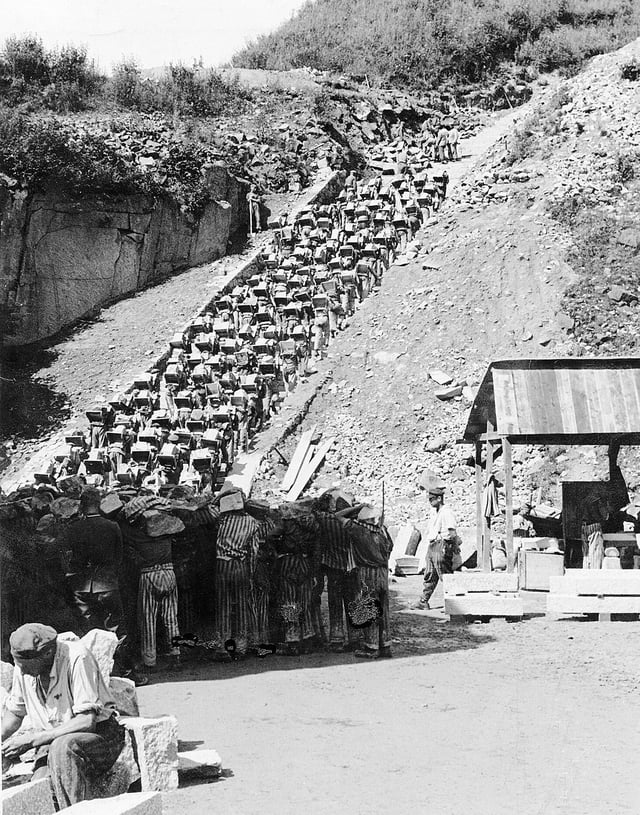
The "stairs of death" at the Weiner Graben quarry, Mauthausen concentration camp, Austria, 1942[286]
Germany first used concentration camps as places of unlawful incarceration of political opponents and other "enemies of the state". Large numbers of Jews were not sent there until after Kristallnacht in November 1938.[287] Although death rates were high, the camps were not designed as killing centers.[288] After war broke out in 1939, new camps were established, some outside Germany in occupied Europe.[289] In January 1945, the SS reports had over 700,000 prisoners in their control, of which close to half had died by the end of May 1945, according to most historians.[290] Most wartime prisoners of the camps were not Germans but belonged to countries under German occupation.[291]
After 1942, the economic functions of the camps, previously secondary to their penal and terror functions, came to the fore. Forced labor of camp prisoners became commonplace.[287] The guards became much more brutal, and the death rate increased as the guards not only beat and starved prisoners, but killed them more frequently.[291] Vernichtung durch Arbeit ("extermination through labor") was a policy—camp inmates would literally be worked to death, or to physical exhaustion, at which point they would be gassed or shot.[292] The Germans estimated the average prisoner's lifespan in a concentration camp at three months, due to lack of food and clothing, constant epidemics, and frequent punishments for the most minor transgressions.[293] The shifts were long and often involved exposure to dangerous materials.[294]
Transportation between camps was often carried out in freight cars with prisoners packed tightly. Long delays would take place; prisoners might be confined in the cars on sidings for days.[295] In mid-1942 work camps began requiring newly arrived prisoners to be placed in quarantine for four weeks.[296] Prisoners wore colored triangles on their uniforms, the color denoting the reason for their incarceration. Red signified a political prisoner, Jehovah's Witnesses had purple triangles, "asocials" and criminals wore black and green, and gay men wore pink.[297] Jews wore two yellow triangles, one over another to form a six-pointed star.[298] In Auschwitz, prisoners were tattooed with an identification number on arrival.[299][300]
Final Solution
Pearl Harbor
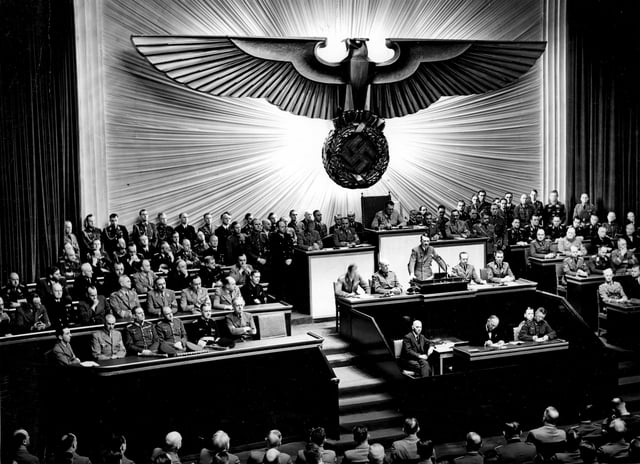
Adolf Hitler speaking at the Kroll Opera House in Berlin to members of the Reichstag about war in the Pacific, 11 December 1941[16]
On 7 December 1941, Japanese aircraft attacked Pearl Harbor, an American naval base in Honolulu, Hawaii, killing 2,403 Americans. The following day, the United States declared war on Japan, and on 11 December, Germany declared war on the United States.[301] According to Deborah Dwork and Robert Jan van Pelt, Hitler had trusted American Jews, whom he assumed were all powerful, to keep the United States out of the war in the interests of German Jews. When America declared war, he blamed the Jews.[302] Nearly three years earlier, on 30 January 1939, he had told the Reichstag: "if the international Jewish financiers in and outside Europe should succeed in plunging the nations once more into a world war, then the result will be not the Bolshevising of the earth, and thus a victory of Jewry, but the annihilation of the Jewish race in Europe!"[303]
In the view of Christian Gerlach, Hitler probably announced his decision to annihilate the Jews on 12 December 1941 during a speech to the Gauleiters, part of the Nazi Party leadership.[304] The following day, Joseph Goebbels, the Reich Minister of Propaganda, noted in his diary: "He warned the Jews that if they were to cause another world war, it would lead to their destruction. ... Now the world war has come. The destruction of the Jews must be its necessary consequence."[301][17]
Wannsee Conference

Pages from the Wannsee Protocol[306] listing the number of Jews in every European country
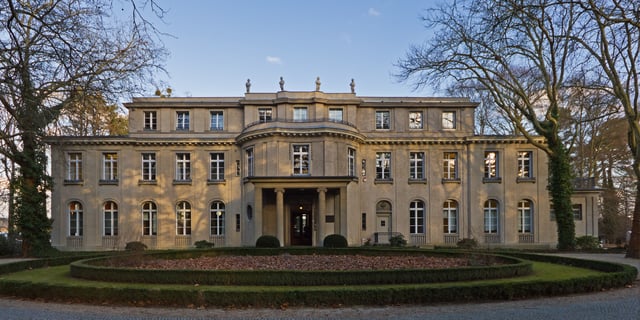
Am Großen Wannsee 56–58, Berlin
SS-Obergruppenführer Reinhard Heydrich, head of the Reich Security Head Office, convened what became known as the Wannsee Conference on 20 January 1942 at Am Großen Wannsee 56–58, a villa in Berlin's Wannsee suburb.[306][307] The meeting had been scheduled for 9 December 1941, and invitations had been sent on 29 November, but it had been postponed indefinitely. A month later, invitations were sent out again, this time for 20 January.[308]
The 15 men present at Wannsee included Adolf Eichmann (head of Jewish affairs for the RSHA and the man who organized the deportation of Jews), Heinrich Müller (head of the Gestapo), and other party leaders and department heads.[306] Thirty copies of the minutes, known as the Wannsee Protocol, were made. Copy no. 16 was found by American prosecutors in March 1947 in a German Foreign Office folder.[309] Written by Eichmann and stamped "Top Secret", the minutes were written in "euphemistic language" on Heydrich's instructions, according to Eichmann's later testimony.[310]
The conference had several purposes. Discussing plans for a "final solution to the Jewish question" ("Endlösung der Judenfrage"), and a "final solution to the Jewish question in Europe" ("Endlösung der europäischen Judenfrage"),[306] it was intended to share information and responsibility, coordinate efforts and policies ("Parallelisierung der Linienführung"), and ensure that authority rested with Heydrich. There was also discussion about whether to include the German Mischlinge (half-Jews).[311] Heydrich told the meeting: "Another possible solution of the problem has now taken the place of emigration, i.e. the evacuation of the Jews to the East, provided that the Fuehrer gives the appropriate approval in advance."[306] He continued:
Under proper guidance, in the course of the final solution the Jews are to be allocated for appropriate labor in the East. Able-bodied Jews, separated according to sex, will be taken in large work columns to these areas for work on roads, in the course of which action doubtless a large portion will be eliminated by natural causes. The possible final remnant will, since it will undoubtedly consist of the most resistant portion, have to be treated accordingly because it is the product of natural selection and would, if released, act as the seed of a new Jewish revival (see the experience of history.) In the course of the practical execution of the final solution, Europe will be combed through from west to east. Germany proper, including the Protectorate of Bohemia and Moravia, will have to be handled first due to the housing problem and additional social and political necessities. The evacuated Jews will first be sent, group by group, to so-called transit ghettos, from which they will be transported to the East.[306]
These evacuations were regarded as provisional or "temporary solutions" ("Ausweichmöglichkeiten").[312][18] The final solution would encompass the 11 million Jews living not only in territories controlled by Germany, but elsewhere in Europe and adjacent territories, such as Britain, Ireland, Switzerland, Turkey, Sweden, Portugal, Spain, and Hungary, "dependent on military developments".[312] There was little doubt what the final solution was, writes Peter Longerich: "the Jews were to be annihilated by a combination of forced labour and mass murder".[314]
Extermination camps
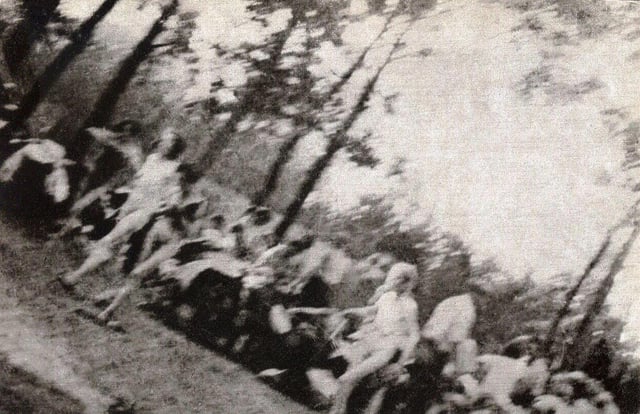
Women on their way to the gas chamber, near Crematorium V, Auschwitz II, August 1944. The Polish resistance reportedly smuggled the film, known as the Sonderkommando photographs, out of the camp in a toothpaste tube.[328]
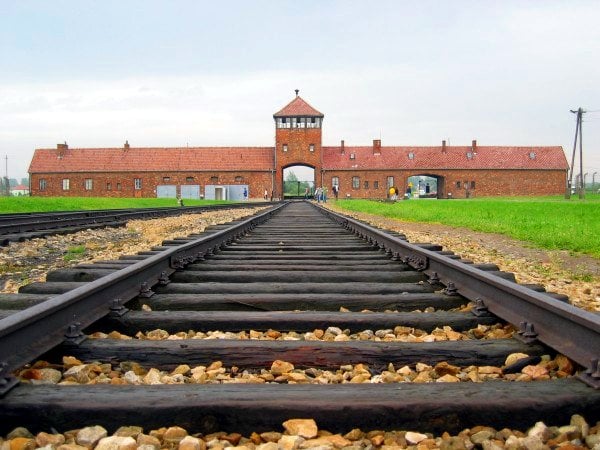
Auschwitz II gatehouse, shot from inside the camp
| Camp | Location in occupied Poland | Killed | Gas chambers | Gas vans | Source |
|---|---|---|---|---|---|
| Auschwitz (all camps) | Oświęcim, Brzezinka, and elsewhere | 1,100,000 | [315] | ||
| Bełżec | Bełżec | 600,000 | [316] | ||
| Chełmno | Chełmno nad Nerem, near Łódź | 320,000 | [317] | ||
| Majdanek | Lublin | 78,000 | [318] | ||
| Sobibór | Sobibór | 250,000 | [319] | ||
| Treblinka | Treblinka | 870,000 | [320] | ||
| Total | 3,218,000 |
From the end of 1941, the Germans built six extermination camps in occupied Poland: Auschwitz II (established October 1941), Majdanek (October 1941), Chełmno (December 1941), Bełżec (1942), Sobibór (1942), and Treblinka (1942); the last three are known as the Operation Reinhard camps.[32][321] Killing on a mass scale using gas chambers or gas vans was the difference between the extermination and concentration camps.[322] Chełmno, with gas vans only, had its roots in the Aktion T4 euthanasia program.[323] Majdanek began as a POW camp but had gas chambers installed in August 1942.[324] Other camps sometimes described as extermination camps include Maly Trostinets, a camp and extermination site near Minsk in the occupied Soviet Union, where 65,000 are thought to have died, mostly by shooting but also in gas vans;[325] Mauthausen in Austria;[326] Stutthof, near Gdańsk, Poland;[327] and Sachsenhausen and Ravensbrück in Germany. The camps in Austria, Germany and Poland all had gas chambers to kill inmates deemed unable to work.[69]
Christian Gerlach writes that over three million Jews were murdered in 1942, the year that "marked the peak" of the mass murder.[329] At least 1.4 million of these were in the General Government area of Poland.[330] Victims usually arrived at the extermination camps by freight train.[331] Almost all arrivals at Bełżec, Sobibór, and Treblinka were sent directly to the gas chambers,[332] with individuals occasionally selected to replace dead workers.[333] At Auschwitz, about 20 percent of Jews were selected to work.[334] Those selected for death at all camps were told to undress and hand their valuables to camp workers.[335] They were then herded naked into the gas chambers. To prevent panic, they were told the gas chambers were showers or delousing chambers.[336] The procedure at Chełmno was slightly different. Victims there were placed in a mobile gas van and asphyxiated, while being driven to prepared burial pits in the nearby forests. There the corpses were unloaded and buried.[337]
At Auschwitz, after the chambers were filled, the doors were shut and pellets of Zyklon-B were dropped into the chambers through vents,[338] releasing toxic prussic acid, or hydrogen cyanide.[339] Those inside died within 20 minutes; the speed of death depended on how close the inmate was standing to a gas vent, according to the commandant Rudolf Höss, who estimated that about one-third of the victims died immediately.[340] Johann Kremer, an SS doctor who oversaw the gassings, testified that: "Shouting and screaming of the victims could be heard through the opening and it was clear that they fought for their lives."[341] The gas was then pumped out, the bodies were removed, gold fillings in their teeth were extracted, and women's hair was cut.[342] The work was done by the Sonderkommando, work groups of mostly Jewish prisoners.[343] At Auschwitz, the bodies were at first buried in deep pits and covered with lime, but between September and November 1942, on the orders of Himmler, they were dug up and burned. In early 1943, new gas chambers and crematoria were built to accommodate the numbers.[344]
At Bełżec, Sobibór, and Treblinka, the victims were killed in gas chambers by the exhaust fumes of stationary diesel engines.[332] Gold fillings were pulled from the corpses before burial, but the women's hair was cut before death. At Treblinka, to calm the victims, the arrival platform was made to look like a train station, complete with fake clock.[345] Majdanek used Zyklon-B gas in its gas chambers.[346] In contrast to Auschwitz, Bełżec, Sobibór, and Treblinka were relatively small.[347] Most of the victims at these camps were buried in pits at first. Sobibór and Bełżec began exhuming and burning bodies in late 1942, to hide the evidence, as did Treblinka in March 1943. The bodies were burned in open fire pits and the remaining bones crushed into powder.[348]
Jewish resistance
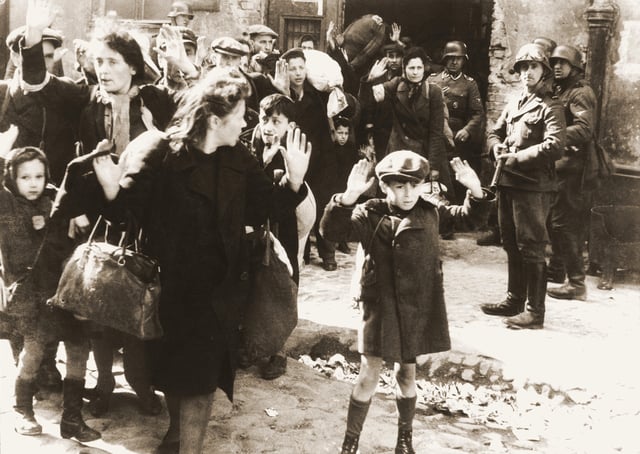
Another Stroop report image of the aftermath of the Warsaw Ghetto Uprising; the SS man on the right with the gun is Josef Blösche.
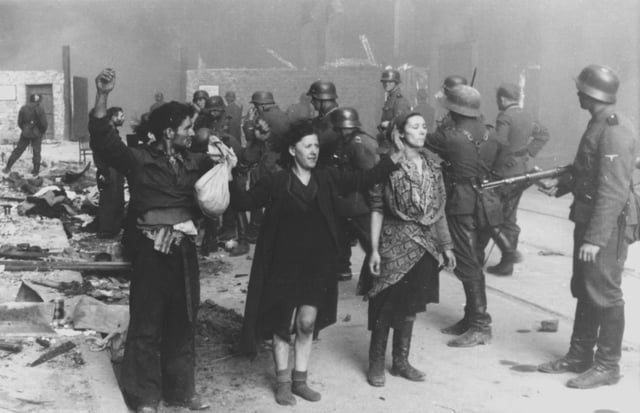
Stroop Report photograph: captured insurgents from the Warsaw Ghetto Uprising, May 1943; the woman on the right is Hasia Szylgold-Szpiro.[349]
There was almost no resistance in the ghettos in Poland until the end of 1942, according to Peter Longerich.[350] Raul Hilberg accounted for this by evoking the history of Jewish persecution: appealing to oppressors and complying with orders might avoid inflaming the situation until the onslaught abated.[351] Timothy Snyder noted that it was only during the three months after the deportations of July–September 1942 that agreement on the need for armed resistance was reached.[352]
Several resistance groups were formed, such as the Jewish Combat Organization (ŻOB) and Jewish Military Union (ŻZW) in the Warsaw Ghetto and the United Partisan Organization in Vilna.[353] Over 100 revolts and uprisings occurred in at least 19 ghettos and elsewhere in Eastern Europe. The best known is the Warsaw Ghetto Uprising in April 1943, when the Germans arrived to send the remaining inhabitants to extermination camps. They had to retreat on 19 April from the ŻOB and ŻZW fighters, and later that day returned under the command of SS General Jürgen Stroop (author of the Stroop Report about the uprising).[354] Around 1,000 poorly armed fighters held the SS at bay for four weeks.[355] According to Polish and Jewish accounts, hundreds or thousands of Germans were killed,[356] while the Germans reported 16 dead.[357] The Germans reported 14,000 Jews killed—7000 during the fighting and 7000 sent to Treblinka[358]—and between 53,000[359] and 56,000 deported.[357] Gwardia Ludowa, a Polish resistance newspaper, wrote in May 1943: "From behind the screen of smoke and fire, in which the ranks of fighting Jewish partisans are dying, the legend of the exceptional fighting qualities of the Germans is being undermined. How infamous 'victory' appears when it is won only by burning and pulling down a whole district of the capital ... The fighting Jews have won for us what is most important: the truth about the weakness of the Germans."[360]
During a revolt in Treblinka on 2 August 1943, inmates killed five or six guards and set fire to camp buildings; several managed to escape.[361] In the Białystok Ghetto on 16 August 1943, Jewish insurgents fought for five days when the Germans announced mass deportations.[362] On 14 October 1943, Jewish prisoners in Sobibór, including Jewish-Soviet prisoners of war, attempted an escape,[363] killing 11 SS officers and a couple of Ukrainian camp guards.[364] Around 300 escaped, but 100 were recaptured and shot.[365] On 7 October 1944, 300 Jewish members of the Sonderkommando at Auschwitz, who learned they were about to be killed, attacked their guards and blew up crematorium IV. Three SS officers were killed, one of whom was stuffed into an oven, as was a German kapo. None of the Sonderkommando rebels survived the uprising.[366]
Estimates of Jewish participation in partisan units throughout Europe range from 20,000 to 100,000.[367] In the occupied Polish and Soviet territories, thousands of Jews fled into the swamps or forests and joined the partisans,[368] although the partisan movements did not always welcome them.[369] An estimated 20,000 to 30,000 joined the Soviet partisan movement.[370] One of the famous Jewish groups was the Bielski partisans in Belarus, led by the Bielski brothers.[368] Jews also joined Polish forces, including the Home Army. According to Timothy Snyder, "more Jews fought in the Warsaw Uprising of August 1944 than in the Warsaw Ghetto Uprising of April 1943".[371][19]
Flow of information about the mass murder
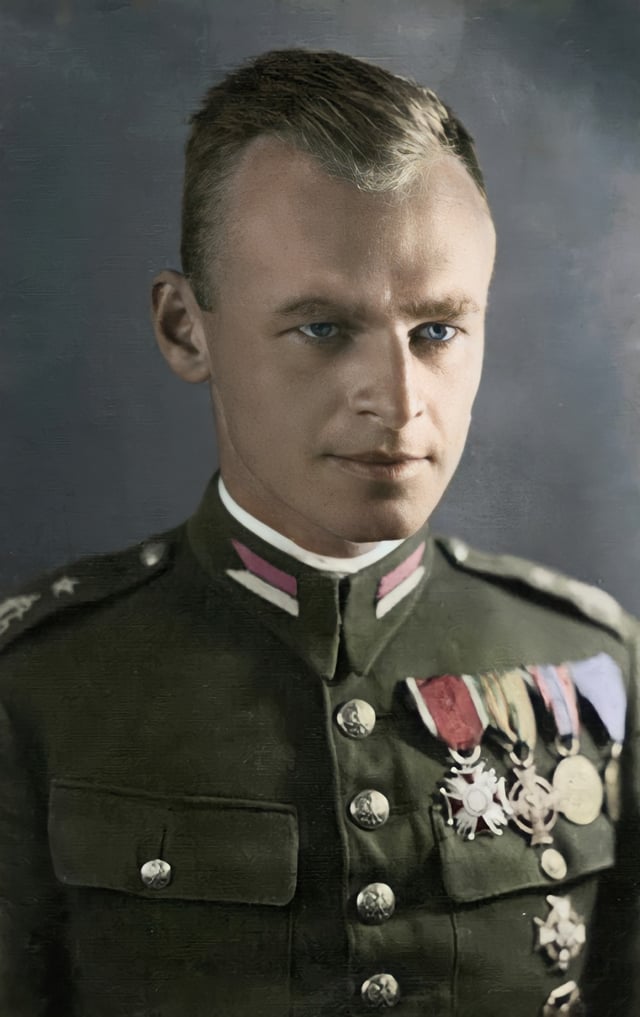
Captain Witold Pilecki

The Mass Extermination of Jews in German Occupied Poland by the Polish government-in-exile, addressed to the United Nations, 10 December 1942
The Polish government-in-exile in London learned about the extermination camps from the Polish leadership in Warsaw, who from 1940 "received a continual flow of information about Auschwitz", according to historian Michael Fleming.[377] This was in large measure thanks to Captain Witold Pilecki of the Polish Home Army, who allowed himself to be arrested in Warsaw and spent 945 days in Auschwitz from September 1940 until April 1943, organizing the resistance movement inside the camp.[378]
On 6 January 1942, the Soviet Minister of Foreign Affairs, Vyacheslav Molotov, sent out diplomatic notes about German atrocities. The notes were based on reports about bodies surfacing from poorly covered graves in pits and quarries, as well as mass graves found in areas the Red Army had liberated, and on witness reports from German-occupied areas.[379] The following month, Szlama Ber Winer escaped from the Chełmno concentration camp in Poland, and passed detailed information about it to the Oneg Shabbat group in the Warsaw Ghetto. His report, known by his pseudonym as the Grojanowski Report, had reached London by June 1942.[317][380] Also in 1942, Jan Karski sent information to the Allies after being smuggled into the Warsaw Ghetto twice.[381] On 27 April 1942, Vyacheslav Molotov sent out another note about atrocities.[379] In late July or early August 1942, Polish leaders learned about the mass killings taking place inside Auschwitz. The Polish Interior Ministry prepared a report, Sprawozdanie 6/42,[382] which said at the end:
There are different methods of execution. People are shot by firing squads, killed by an "air hammer", and poisoned by gas in special gas chambers. Prisoners condemned to death by the Gestapo are murdered by the first two methods. The third method, the gas chamber, is employed for those who are ill or incapable of work and those who have been brought in transports especially for the purpose/Soviet prisoners of war, and, recently Jews.[377]
Sprawozdanie 6/42 was sent to Polish officials in London by courier and had reached them by 12 November 1942, when it was translated into English and added to another report, "Report on Conditions in Poland". Dated 27 November, this was forwarded to the Polish Embassy in the United States.[383] On 10 December 1942, the Polish Foreign Affairs Minister, Edward Raczyński, addressed the fledgling United Nations on the killings; the address was distributed with the title The Mass Extermination of Jews in German Occupied Poland. He told them about the use of poison gas; about Treblinka, Bełżec and Sobibór; that the Polish underground had referred to them as extermination camps; and that tens of thousands of Jews had been killed in Bełżec in March and April 1942.[384] One in three Jews in Poland were already dead, he estimated, from a population of 3,130,000.[385] Raczyński's address was covered by the New York Times and The Times of London. Winston Churchill received it, and Anthony Eden presented it to the British cabinet. On 17 December 1942, 11 Allies issued the Joint Declaration by Members of the United Nations condemning the "bestial policy of cold-blooded extermination".[386][387]
The British and American governments were reluctant to publicize the intelligence they had received. A BBC Hungarian Service memo, written by Carlile Macartney, a BBC broadcaster and senior Foreign Office adviser on Hungary, stated in 1942: "We shouldn't mention the Jews at all." The British government's view was that the Hungarian people's antisemitism would make them distrust the Allies if their broadcasts focused on the Jews.[388] The US government similarly feared turning the war into one about the Jews; antisemitism and isolationism were common in the US before its entry into the war.[389] Although governments and the German public appear to have understood what was happening, it seems the Jews themselves did not. According to Saul Friedländer, "[t]estimonies left by Jews from all over occupied Europe indicate that, in contradistinction to vast segments of surrounding society, the victims did not understand what was ultimately in store for them." In Western Europe, he writes, Jewish communities seem to have failed to piece the information together, while in Eastern Europe, they could not accept that the stories they heard from elsewhere would end up applying to them too.[390]
Climax, Holocaust in Hungary

Jews from the Tét ghetto in Hungary arrive at Auschwitz II, c. May 1944.
Most of the Jewish ghettos of General Government were liquidated in 1942–1943, and their populations shipped to the camps for extermination.[391] The only exception was Lodz Ghetto, which was not liquidated until mid-1944.[392] About 42,000 Jews were shot during the Operation Harvest Festival on 3–4 November 1943.[393] At the same time, rail shipments arrived regularly from western and southern Europe at the extermination camps.[394] Few Jews were shipped from the occupied Soviet territories to the camps: the killing of Jews in this zone was mostly left in the hands of the SS, aided by locally recruited auxiliaries.[395][20]
Shipments of Jews to the camps had priority on the German railways over anything but the army's needs, and continued even in the face of the increasingly dire military situation at the end of 1942.[397] Army leaders and economic managers complained about this diversion of resources and the killing of skilled Jewish workers,[398] but Nazi leaders rated ideological imperatives above economic considerations.[399]
By 1943 it was evident to the armed forces leadership that Germany was losing the war.[400] The mass murder continued nevertheless, reaching a "frenetic" pace in 1944.[401] Auschwitz was gassing up to 6,000 Jews a day by spring that year.[402] On 19 March 1944, Hitler ordered the military occupation of Hungary and dispatched Eichmann to Budapest to supervise the deportation of the country's Jews.[403] From 22 March, Jews were required to wear the yellow star; forbidden from owning cars, bicycles, radios or telephones; then forced into ghettos.[404] From 15 May to 9 July, 440,000 Jews were deported from Hungary to Auschwitz-Birkenau, almost all to the gas chambers.[21] A month before the deportations began, Eichmann offered to exchange one million Jews for 10,000 trucks and other goods from the Allies, the so-called "blood for goods" proposal.[407] The Times called it "a new level of fantasy and self-deception".[408]
Death marches
By mid-1944 those Jewish communities within easy reach of the Nazi regime had been largely exterminated,[409] in proportions ranging from about 25 percent in France[410] to more than 90 percent in Poland.[411] On 5 May Himmler claimed in a speech that "the Jewish question has in general been solved in Germany and in the countries occupied by Germany".[412] As the Soviet armed forces advanced, the camps in eastern Poland were closed down, with surviving inmates shipped to camps closer to Germany.[413] Efforts were made to conceal evidence of what had happened. The gas chambers were dismantled, the crematoria dynamited, and the mass graves dug up and the corpses cremated.[414] Local commanders continued to kill Jews, and to shuttle them from camp to camp by forced "death marches".[415] Already sick after months or years of violence and starvation, some were marched to train stations and transported for days at a time without food or shelter in open freight cars, then forced to march again at the other end to the new camp. Others were marched the entire distance to the new camp. Those who lagged behind or fell were shot. Around 250,000 Jews died during these marches.[416]
Liberation
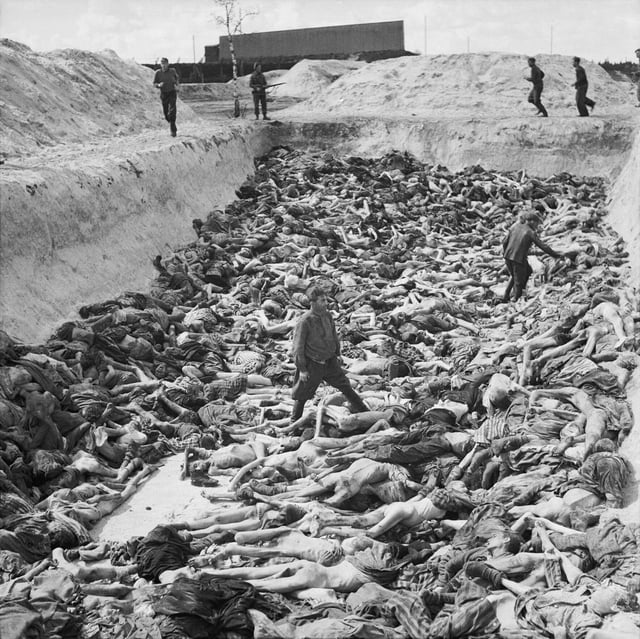
Fritz Klein, the camp doctor, standing in a mass grave at Bergen-Belsen after the camp's liberation by the British 11th Armoured Division, April 1945
The first major camp to be encountered by Allied troops, Majdanek, was discovered by the advancing Soviets on 25 July 1944.[417] Treblinka, Sobibór, and Bełżec were never liberated, but were destroyed by the Germans in 1943.[418] Auschwitz was liberated, also by the Soviets, on 27 January 1945, where they found 7,600 inmates;[419] Buchenwald by the Americans on 11 April;[420] Bergen-Belsen by the British on 15 April;[421] Dachau by the Americans on 29 April;[422] Ravensbrück by the Soviets on 30 April;[423] and Mauthausen by the Americans on 5 May.[424] The Red Cross took control of Theresienstadt on 4 May, days before the Soviets arrived.[425]
The British 11th Armoured Division found around 60,000 prisoners when they liberated Bergen-Belsen,[426] as well as 13,000 unburied corpses; another 10,000 people died from typhus or malnutrition over the following weeks.[427] The BBC's war correspondent Richard Dimbleby described the scenes that greeted him and the British Army at Belsen, in a report so graphic the BBC declined to broadcast it for four days, and did so, on 19 April, only after Dimbleby threatened to resign.[428] He said he had "never seen British soldiers so moved to cold fury".[429]
Here over an acre of ground lay dead and dying people. You could not see which was which. ... The living lay with their heads against the corpses and around them moved the awful, ghostly procession of emaciated, aimless people, with nothing to do and with no hope of life, unable to move out of your way, unable to look at the terrible sights around them ... Babies had been born here, tiny wizened things that could not live. ... A mother, driven mad, screamed at a British sentry to give her milk for her child, and thrust the tiny mite into his arms. ... He opened the bundle and found the baby had been dead for days. This day at Belsen was the most horrible of my life.— Richard Dimbleby, 15 April 1945[430][429]
Death toll
| Country | Death toll of Jews[22] |
|---|---|
| Albania | 591 |
| Austria | 65,459 |
| Baltic states | 272,000 |
| Belgium | 28,518 |
| Bulgaria | 11,393 |
| Croatia | 32,000 |
| Czechoslovakia | 143,000 |
| Denmark | 116 |
| France | 76,134 |
| Germany | 165,000 |
| Greece | 59,195 |
| Hungary | 502,000 |
| Italy | 6,513 |
| Luxembourg | 1,200 |
| Netherlands | 102,000 |
| Norway | 758 |
| Poland | 2,100,000 |
| Romania | 220,000 |
| Serbia | 10,700 |
| Soviet Union | 2,100,000 |
| Total | 5,896,577 |
According to the Yad Vashem Holocaust Martyrs' and Heroes' Remembrance Authority in Jerusalem, "[a]ll the serious research" confirms that between five and six million Jews died.[23] Early postwar calculations were 4.2 to 4.5 million from Gerald Reitlinger;[436] 5.1 million from Raul Hilberg; and 5.95 million from Jacob Lestschinsky.[437] In 1986 Lucy S. Dawidowicz used the pre-war census figures to estimate 5.934 million.[438] Yehuda Bauer and Robert Rozett in the Encyclopedia of the Holocaust (1990) estimated 5.59–5.86 million.[439] In 1991 Wolfgang Benz suggested 5.29 to just over 6 million,[440] and Martin Gilbert arrived at a minimum of 5.75 million.[441] The figures include over one million children.[442]
The Jews killed represented around one third of the world population of Jews,[443] and about two-thirds of European Jewry, based on an estimate of 9.7 million Jews in Europe at the start of the war.[444] Much of the uncertainty stems from the lack of a reliable figure for the number of Jews in Europe in 1939, numerous border changes that make avoiding double-counting of victims difficult, lack of accurate records from the perpetrators, and uncertainty about whether to include deaths caused by the persecution but which occurred months after liberation.[436] After 1941 and the beginning of systematic killing of Jews by the Nazis, escape became a matter of life and death in countries occupied by Germany. The few people willing to help Jews took sometimes tremendous personal risk and, mainly due to Nazi pressure, countries accepted refugees in low numbers only after 1941.[24][445] According to Timothy Snyder, death rates were heavily dependent on the survival of European states to protect their Jewish citizens: "75 per cent of Jews [died] in the Netherlands" and "in Estonia 99 per cent of them were killed", while "75 per cent [survived] in France" and "99 per cent in Denmark".[446]
Almost all Jews living in German-occupied Poland and USSR (including the Baltics) were killed. The Soviet Union was home to 3,020,000 Jews in 1939. The Nazis, helped by local and Romanian collaborators, had killed around one million Jews in mass shootings in the Soviet Union by the end of 1941,[447][448][449] 1–1.3 million Soviet Jews died from Nazi shooting operations and gas wagons.[450][30] More than 1 million of them had escaped the Nazis to the unoccupied part of the USSR after June 1941.[445] Of Poland's 3.3 million Jews, about 90 percent were killed.[411] Many died in the ghettos of Poland before they could be deported,[451] and the remaining 10% Polish Jews who survived had managed to flee towards the Soviet zone before 1941.[445]
The death camps accounted for half the number of Jews killed; 80–90 percent of death-camp victims are estimated to have been Jews.[438] At Auschwitz the Jewish death toll was 960,000;[452] Treblinka 870,000–925,000;[453] Bełżec 434,000–600,000;[454][316] Chełmno 152,000–320,000;[455][317] Sobibór 170,000–250,000;[456][319] and Majdanek 79,000.[318]
Other victims of Nazi persecution
Soviet citizens and POWs
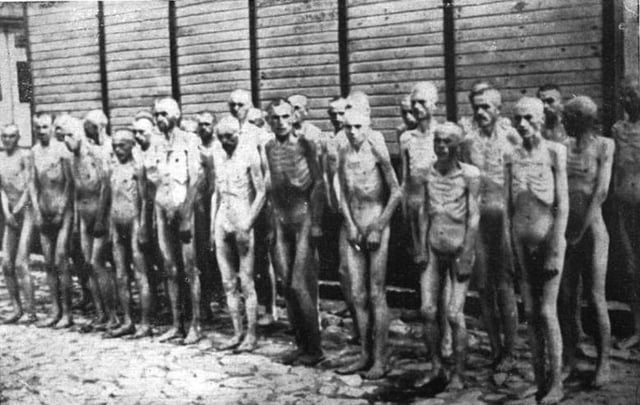
Soviet POWs in the Mauthausen concentration camp, Austria
Soviet civilian populations in the occupied areas were heavily persecuted.[457] Villages throughout the Soviet Union were destroyed by German troops.[458] Germans rounded up civilians for forced labor in Germany and caused famine by taking foodstuffs (see Hunger Plan).[459] In Belarus, Germany imposed a regime that deported approximately 380,000 people for slave labor and killed hundreds of thousands of civilians. Over 600 villages had their entire populations killed, and at least 5,295 Belarusian settlements were destroyed by the Germans. According to Timothy Snyder, of "the nine million people who were in the territory of Soviet Belarus in 1941, around 1.6 million were killed by the Germans in actions away from battlefields, including about 700,000 prisoners of war, 500,000 Jews, and 320,000 people counted as partisans (the vast majority of whom were unarmed civilians)".[460] The United States Holocaust Memorial Museum has estimated that 3.3 million of 5.7 million Soviet POWs died in German custody.[461] The death rates decreased as the POWs were needed to help the German war effort; by 1943, half a million had been deployed as slave labor.[462]
Non-Jewish Poles
| Group | Estimate killed | Source |
|---|---|---|
| Soviet civilians (excl. 1.3 million Jews) | 5.7 million | [30] |
| Soviet POWs (incl. c. 50,000 Jewish soldiers) | 3 million | [30] |
| Non-Jewish Poles | c. 1.8 million | [30][463] |
| Serb civilians | 312,000 | [30] |
| Disabled | Up to 250,000 | [30] |
| Roma | 196,000–220,000 | [30] |
| Jehovah's Witnesses | c. 1,900 | [30][464] |
| Criminals and "asocials" | at least 70,000 | [30] |
| Gay men | Hundreds; unknown | [30][465] |
| Political opponents, resistance | Unknown | [30] |
The Nazis regarded the Slavs as Untermenschen (subhuman).[466] In November 1939 German planners called for "the complete destruction" of all Poles[467] and resettlement of the land by German colonists.[468] In a secret memorandum dated 25 May 1940, Himmler stated that it was in German interests to foster divisions between the ethnic groups in the East. He wanted to restrict non-Germans in the conquered territories to schools that would only teach them how to write their own name, count up to 500, and obey Germans.[469] The Polish political class was the target of a campaign of murder (Intelligenzaktion and AB-Aktion).[470]
Between 1.8 and 1.9 million non-Jewish Polish citizens perished at German hands during the course of the war; about four-fifths were ethnic Poles and the rest Ukrainians and Belarusians.[463] At least 200,000 died in concentration camps, around 146,000 in Auschwitz. Others died in massacres or in uprisings such as the Warsaw Uprising, where 120,000–200,000 were killed.[471] During the occupation, the Germans adopted a policy of restricting food and medical services, as well as degrading sanitation and public hygiene.[472] The death rate rose from 13 per 1000 before the war to 18 per 1000 during the war.[473] Around 6 million of World War II victims were Polish citizens; half the death toll were Jews. Over the course of the war Poland lost 20 percent of its pre-war population.[474] Over 90 percent of the death toll came through non-military losses, through various deliberate actions by Germany and the Soviet Union.[471] Polish children were also kidnapped by Germans to be "Germanized".[475]
Roma
Germany and its allies killed up to 220,000 Roma, around 25 percent of the community in Europe,[476] in what the Romani people call the Pořajmos.[477] In May 1942, they were placed under similar laws to the Jews; Himmler later issued a decree that "Gypsy Mischlinge [mixed breeds], Roma Gypsies, and members of the clans of Balkan origins who are not of German blood" should be sent to Auschwitz, unless they had served in the Wehrmacht.[478][25] The Roma in Belgium, France, Luxembourg, and the Netherlands were subject to restrictions on movement and confinement to collection camps, while in Central and Eastern Europe they were sent to the ghettos, including the Warsaw Ghetto,[280] and concentration camps. In the camps, they were usually counted among the asocials and required to wear black triangles, before being murdered.[481] Further east, teams of Einsatzgruppen tracked down Romani encampments and murdered the inhabitants on the spot.[482] After the Germans occupied Hungary, 1,000 Roma were deported to Auschwitz.[483] The Roma were also targeted by Germany's allies, such as the Ustaše in Croatia, where a large number were killed in the Jasenovac concentration camp;[482] the total killed in Croatia numbered around 28,000.[484]
Political and religious opponents
German communists, socialists and trade unionists were among the earliest opponents of the Nazis[485] and among the first to be sent to concentration camps.[486] Before the invasion of the Soviet Union, Hitler issued the Commissar Order, which ordered the execution of all political commissars and Communist Party members captured.[487] Nacht und Nebel ("Night and Fog") was a directive of Hitler in December 1941, resulting in the disappearance of political activists throughout the German-occupied territories.[488] Because they refused to pledge allegiance to the Nazi party or serve in the military, Jehovah's Witnesses were sent to concentration camps, where they were identified by purple triangles and given the option of renouncing their faith and submitting to the state's authority.[489] The United States Holocaust Memorial Museum estimates that between 2,700 and 3,300 were sent to the camps, where 1,400 died;[464] in The Holocaust Encyclopedia (2001), Sybil Milton estimates that 10,000 were sent and 2,500 died.[490] According to German historian Detlef Garbe, "no other religious movement resisted the pressure to conform to National Socialism with comparable unanimity and steadfastness."[491]
Gay men
Around 50,000 German gay men were jailed between 1933 and 1945, and 5,000–15,000 are estimated to have been sent to concentration camps. It is not known how many died during the Holocaust era.[465][492] In 1936, Himmler created the Reich Central Office for the Combating of Homosexuality and Abortion.[493] The Gestapo raided gay bars, tracked individuals using the address books of those they arrested, used the subscription lists of gay magazines to find others, and encouraged people to report suspected homosexual behavior and to scrutinize the behavior of their neighbors.[494] Lesbians were left relatively unaffected;[465] the Nazis saw them as "asocials", rather than sexual deviants.[495] Gay men convicted between 1933 and 1944 were sent to camps for "rehabilitation", where they were identified by pink triangles.[494] Hundreds were castrated, sometimes "voluntarily" to avoid criminal sentences.[496] James Steakley wrote in 1974 that the full extent of gay suffering was slow to emerge after the war. Many victims kept their stories to themselves because homosexuality remained criminalized in postwar Germany.[494]
Black people
The number of Afro-Germans in Germany when the Nazis came to power is variously estimated at 5,000–25,000.[497] It is not clear whether these figures included Asians. Although blacks in Germany and German-occupied Europe, including prisoners of war, were subjected to incarceration, sterilization, murder, and other abuse, there was no programme to kill them all as there was for the Jews.[498]
Aftermath
Trials
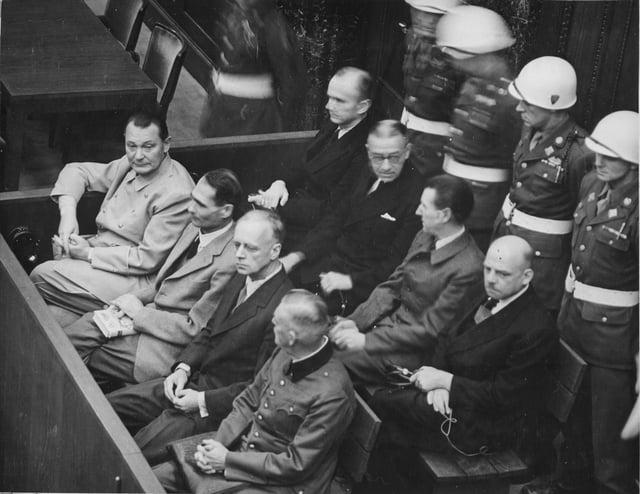
Defendants in the dock at the Nuremberg trials, 1945–1946. (Front row, left to right): Hermann Göring, Rudolf Heß, Joachim von Ribbentrop, Wilhelm Keitel(Second row, left to right): Karl Dönitz, Erich Raeder, Baldur von Schirach, Fritz Sauckel
The Nuremberg trials were a series of military tribunals, held after the war by the Allies in Nuremberg, Germany, to prosecute the German leadership. The first was the 1945–1946 trial of the major war criminals before the International Military Tribunal (IMT).[499] This tribunal tried 22 political and military leaders,[500] except for Adolf Hitler, Heinrich Himmler, and Joseph Goebbels, all of whom had committed suicide several months before.[499]
The prosecution entered indictments against 24 major war criminals[26] and seven organizations: the Reich Cabinet, the Schutzstaffel (SS), Sicherheitsdienst (SD), the Gestapo, the Sturmabteilung (SA) and the "General Staff and High Command". The indictments were for participation in a common plan or conspiracy for the accomplishment of a crime against peace; planning, initiating and waging wars of aggression and other crimes against peace; war crimes; and crimes against humanity. The tribunal passed judgements ranging from acquittal to death by hanging.[501] Eleven defendants were executed, including Joachim von Ribbentrop, Wilhelm Keitel, Alfred Rosenberg, and Alfred Jodl. Ribbentrop, the judgement declared, "played an important part in Hitler's 'final solution of the Jewish question'".[502]
Further trials at Nuremberg took place between 1946 and 1949, which tried another 185 defendants.[503] West Germany initially tried few ex-Nazis, but after the 1958 Ulm Einsatzkommando trial, the government set up a governmental agency to investigate crimes.[504] Other trials of Nazis and collaborators took place in Western and Eastern Europe. In 1960, Mossad agents captured Adolf Eichmann in Argentina and brought him to Israel to stand trial on 15 indictments, including war crimes, crimes against humanity, and crimes against the Jewish people. He was convicted in December 1961 and executed in June 1962. Eichmann's trial and death revived interest in war criminals and the Holocaust in general.[505]
Reparations
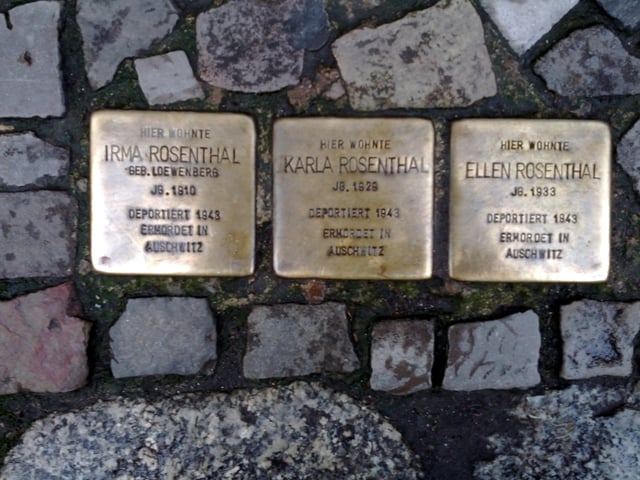
Stolpersteine, Berlin-Mitte, 2011
In March 1951, the government of Israel requested $1.5 billion from the Federal Republic of Germany to finance the rehabilitation of 500,000 Jewish survivors, arguing that Germany had stolen $6 billion from the European Jews. Israelis were divided about the idea of taking money from Germany. The Conference on Jewish Material Claims Against Germany (known as the Claims Conference) was opened in New York, and after negotiations, the claim was reduced to $845 million.[506][507]
In 1988, West Germany allocated another $125 million for reparations. Companies such as BMW, Deutsche Bank, Ford, Opel, Siemens, and Volkswagen faced lawsuits for their use of forced labor during the war.[506] In response, Germany set up the "Remembrance, Responsibility and Future" Foundation in 2000, which paid €4.45 billion to former slave laborers (up to €7,670 each).[508] In 2013, Germany agreed to provide €772 million to fund nursing care, social services, and medication for 56,000 Holocaust survivors around the world.[509] The French state-owned railway company, the SNCF, agreed in 2014 to pay $60 million to Jewish-American survivors, around $100,000 each, for its role in the transport of 76,000 Jews from France to extermination camps between 1942 and 1944.[510]
Motivation

Holocaust perpetrators Heinrich Himmler, Reinhard Heydrich and Karl Wolff at the Berghof, from silent color film shot by Eva Braun, May 1939
In his 1965 essay "Command and Compliance", which originated in his work as an expert witness for the prosecution at the Frankfurt Auschwitz Trials, the German historian Hans Buchheim wrote there was no coercion to murder Jews and others, and all who committed such actions did so out of free will. Buchheim wrote that chances to avoid executing criminal orders "were both more numerous and more real than those concerned are generally prepared to admit",[511] and that he found no evidence that SS men who refused to carry out criminal orders were sent to concentration camps or executed.[512] Moreover, SS rules prohibited acts of gratuitous sadism, as Himmler wished for his men to remain "decent"; acts of sadism were carried out on the initiative of those who were either especially cruel or wished to prove themselves ardent National Socialists.[511] Finally, he argued that those of a non-criminal bent who committed crimes did so because they wished to conform to the values of the group they had joined and were afraid of being branded "weak" by their colleagues if they refused.[513]
Similarly, in Ordinary Men (1992), Christopher Browning examined the deeds of German Reserve Police Battalion 101 of the Ordnungspolizei ("order police"), used to commit massacres and round-ups of Jews, as well as mass deportations to the death camps. The members of the battalion were middle-aged men of working-class background from Hamburg, who were too old for regular military duty. They were given no special training. During the murder of 1,500 Jews from Józefów in Poland, their commander allowed them to opt out of direct participation. Fewer than 12 men out of a battalion of 500 did so. Influenced by the Milgram experiment on obedience, Browning argued that the men killed out of peer pressure, not bloodlust.[514]
In his 1983 book, Popular Opinion and Political Dissent in the Third Reich, Ian Kershaw examined the Alltagsgeschichte (history of everyday life) in Bavaria during the Nazi period. The most common viewpoint of Bavarians was indifference towards what was happening to the Jews, he wrote. Most Bavarians were vaguely aware of the genocide, but they were vastly more concerned about the war.[515] Kershaw argued that "the road to Auschwitz was built by hate, but paved with indifference".[516] His assessment faced criticism from historians Otto Dov Kulka and Michael Kater. Kater maintained that Kershaw had downplayed the extent of popular antisemitism. Although most of the "spontaneous" antisemitic actions of Nazi Germany had been staged, Kater argued that these had involved substantial numbers of Germans, and therefore it was wrong to view the extreme antisemitism of the Nazis as coming solely from above.[517] Kulka argued that "passive complicity" would be a better term than "indifference".[518] Focusing on the views of Germans opposed to the Nazi regime, the German historian Christof Dipper, in his essay "Der Deutsche Widerstand und die Juden" (1983), argued that the majority of the anti-Nazi national-conservatives were antisemitic. No one in the German resistance supported the Holocaust, but Dipper wrote that the national conservatives did not intend to restore civil rights to the Jews after the planned overthrow of Hitler.[517]
Uniqueness question
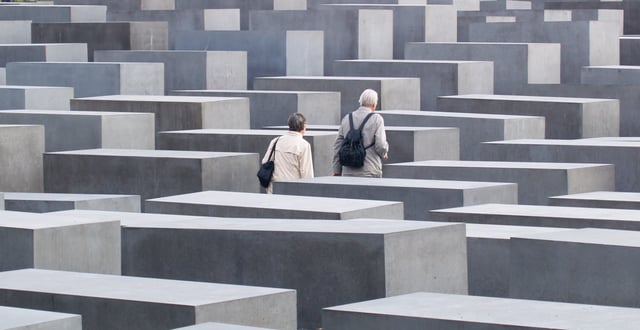
Memorial to the Murdered Jews of Europe, Berlin, 2008
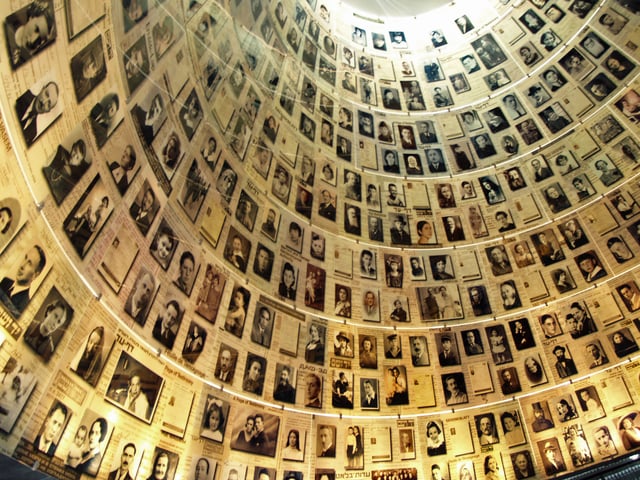
Yad Vashem in Israel, 2007
In the first few decades after the Holocaust, scholars argued that it was unique as a genocide in its reach and specificity.[519] This began to change in the 1980s during the West German Historikerstreit ("historians' dispute"), an attempt to re-position the Holocaust within German historiography. Ernst Nolte triggered the dispute in June 1986 with an article in the Frankfurter Allgemeine Zeitung: "Vergangenheit, die nicht vergehen will: Eine Rede, die geschrieben, aber nicht mehr gehalten werden konnte" ("The past that will not pass: A speech that could be written but not delivered"), in which he compared Auschwitz to the Gulag and suggested that the Holocaust was a response to Hitler's fear of the Soviet Union: "Was the Bolshevik murder of an entire class not the logical and factual prius of the 'racial murder' of National Socialism? ... Was the source of Auschwitz a past that would not go away?"[27]
Nolte's views were widely denounced. The debate between the "specifists" and "universalists" was acrimonious; the former feared debasement of the Holocaust and the latter considered it immoral to hold the Holocaust as beyond compare.[521] In her book Denying the Holocaust (1993), Deborah Lipstadt viewed Nolte's position as a form of Holocaust denial, or at least "the same triumph of ideology over truth".[522] Addressing Nolte's argument, Eberhard Jäckel wrote in Die Zeit in September 1986 that "never before had a state, with the authority of its leader, decided and announced that a specific group of humans, including the elderly, women, children and infants, would be killed as quickly as possible, then carried out this resolution using every possible means of state power".[8] Despite the criticism of Nolte, Dan Stone wrote in 2010 that the Historikerstreit put "the question of comparison" on the agenda.[523] He argued that the idea of the Holocaust as unique has been overtaken by attempts to place it within the context of early-20th-century Stalinism, ethnic cleansing, and the Nazis' intentions for post-war "demographic reordering", particularly the Generalplan Ost, the plan to kill tens of millions of Slavs to create living space for Germans.[524] The specifist position continued nevertheless to inform the views of many specialists. Richard J. Evans argued in 2015:
Thus although the Nazi 'Final Solution' was one genocide among many, it had features that made it stand out from all the rest as well. Unlike all the others it was bounded neither by space nor by time. It was launched not against a local or regional obstacle, but at a world-enemy seen as operating on a global scale. It was bound to an even larger plan of racial reordering and reconstruction involving further genocidal killing on an almost unimaginable scale, aimed, however, at clearing the way in a particular region – Eastern Europe – for a further struggle against the Jews and those the Nazis regarded as their puppets. It was set in motion by ideologues who saw world history in racial terms. It was, in part, carried out by industrial methods. These things all make it unique.— Richard Evans, "Was the 'Final Solution' Unique?", The Third Reich in History and Memory.[525]
Awareness
In September 2018, an online CNN–ComRes poll of 7,092 adults in seven European countries—Austria, France, Germany, Great Britain, Hungary, Poland, and Sweden—found that one in 20 had never heard of the Holocaust. The figure included one in five people in France between the ages of 18 and 34. Four in 10 Austrians said they knew "just a little" about it; 12 percent of young people there said they had never heard of it.[526] A 2018 survey organized in the United States by the Claims Conference, United States Holocaust Memorial Museum, and others found that 22 percent of 1,350 adults said they had never heard of the Holocaust, while 41 percent and 66 percent of millennials did not know what Auschwitz was.[527] In 2019, a survey of 1,100 Canadians found that 49 percent could not name any of the concentration camps.[528] In an online poll of 2,006 people in the UK in 2019 for the Holocaust Memorial Day Trust, 45 percent did not know how many were murdered in the Holocaust, 19 percent believed that the number of Jews murdered was fewer than two million, and 5.4 percent said they did not believe the Holocaust had happened at all.[529]
See also
Holocaust victims
Holocaust studies
History of the Jews during World War II
Individuals and groups assisting Jews during the Holocaust
International Holocaust Remembrance Day
International response to the Holocaust
List of Holocaust memorials and museums
List of Holocaust survivors
Rescue of Jews by Poles during the Holocaust
Righteous Among the Nations
Timeline of the Holocaust




